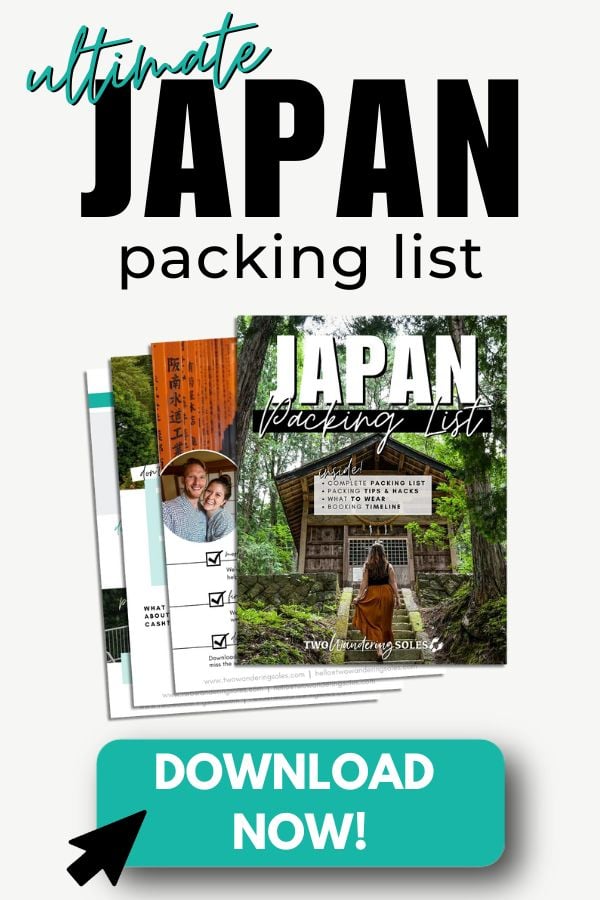We’re breaking down exactly how to plan the perfect family trip to Japan so you’re prepared and have the best time possible. This guide is full of practical tips and advice that’ll make planning a breeze!
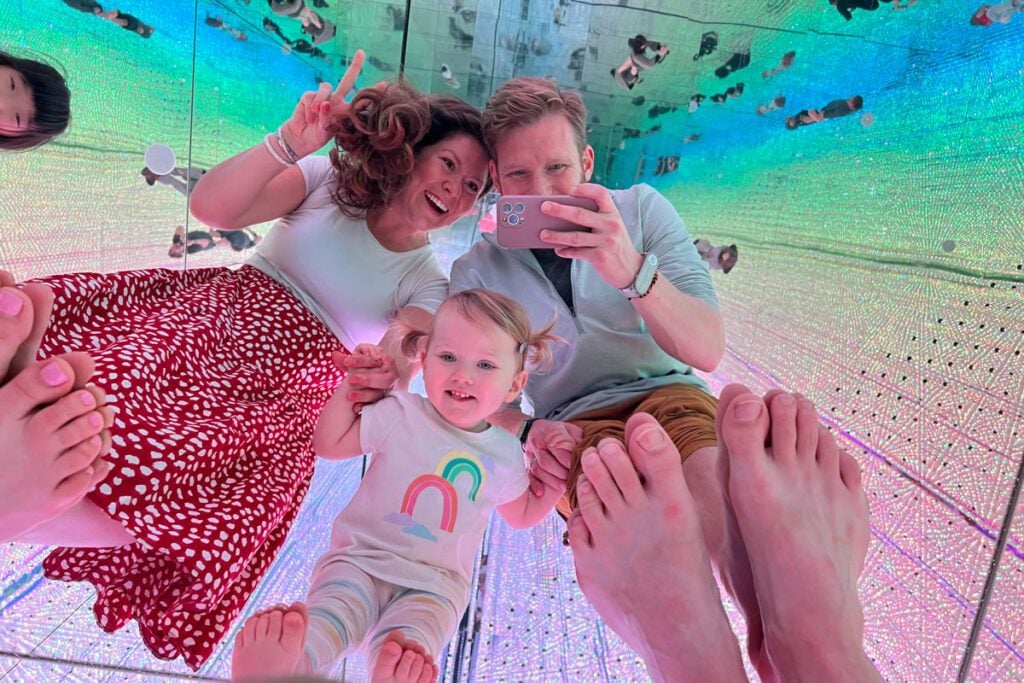
You’re likely here because the thought of traveling to Japan with kids has crossed your mind.
Or perhaps you’re already deep into planning your dream family vacation to the Land of the Rising Sun.
Maybe your flight leaves tomorrow and you’re all of a sudden having second thoughts (in which case, take a deep breath – we can help!).
Whatever the case, we are here to calm your nerves, share all our personal experience, and leave you with practical tips to make your family trip to Japan unforgettable (for all the right reasons!).
Plus, we’re sharing some items to pack that will make your life SO much easier if you’re traveling in Japan with kids.
Plan the perfect family trip to Japan
- Is Japan a good place to travel with kids?
- Japan with kids PROS
- Japan with kids CONS
- Our experience
- Tips for traveling in Japan with kids
- Trains in Japan with kids
- Japanese food with kids
- What to pack for Japan with kids
- Child-friendly activities in Japan
First things first:
Is Japan a good place to travel with kids?
Absolutely!
Or at least, in our personal opinions, it absolutely is.
There are definitely some things about traveling in Japan that make it a different beast than traveling many other places around the world.
But overall, we think a family trip to Japan makes an incredible vacation.
Here’s why:
Traveling in Japan with kids PROS
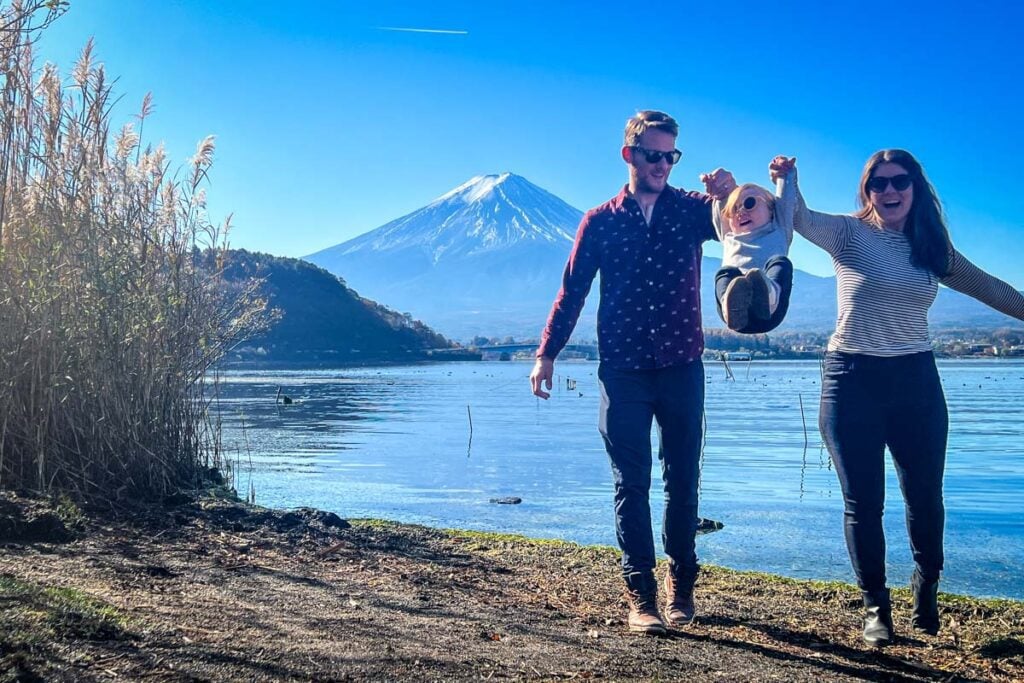
- Public transportation and bathrooms around the country are all very accommodating for families with children
- Cities are clean and generally accessible with strollers
- There are many fun things to do that are very child-friendly
- We found most restaurants and hotels to be very accommodating
Traveling in Japan with kids CONS
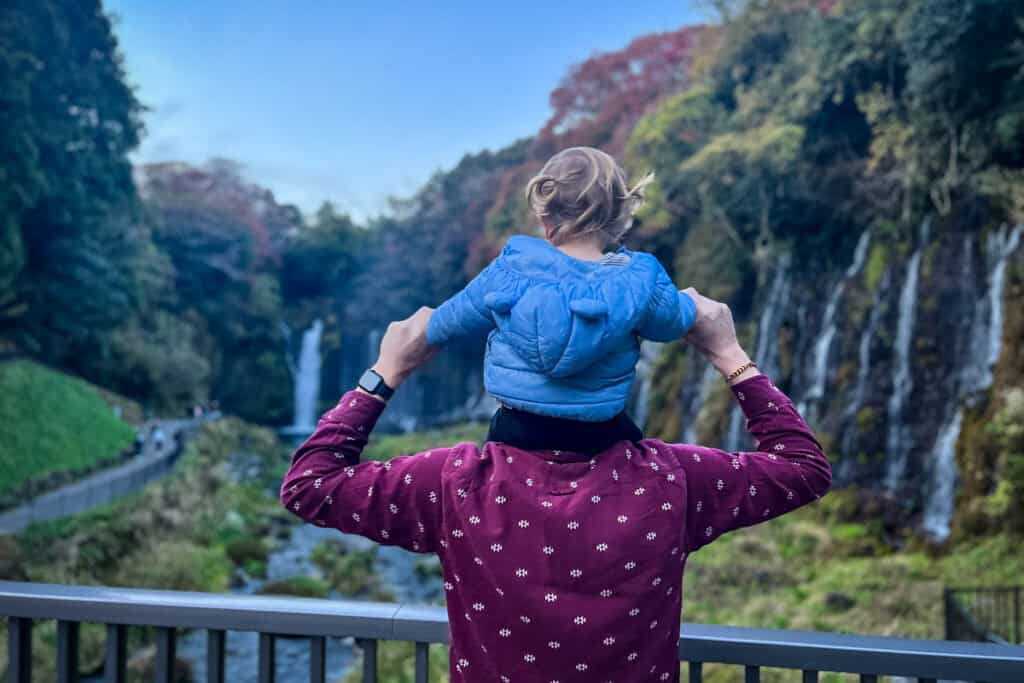
- If you’re coming from North America or Europe, you’ll be dealing with a major time difference
- Japan is generally a somewhat expensive country to travel (but we do have some budget tips and what to expect here)
- No matter what your itinerary is, you will be doing a LOT of walking, so you need to be prepared for that
- It can be hard to find breakfast options or things to do in the mornings, as places tend to open later (usually 10 or 11 a.m.)
- Unless you speak Japanese, there can be a language barrier (but we’ve found learning a few key Japanese words and phrases paired with Google Translate to be incredibly helpful!)
Our personal experience traveling in Japan with a toddler
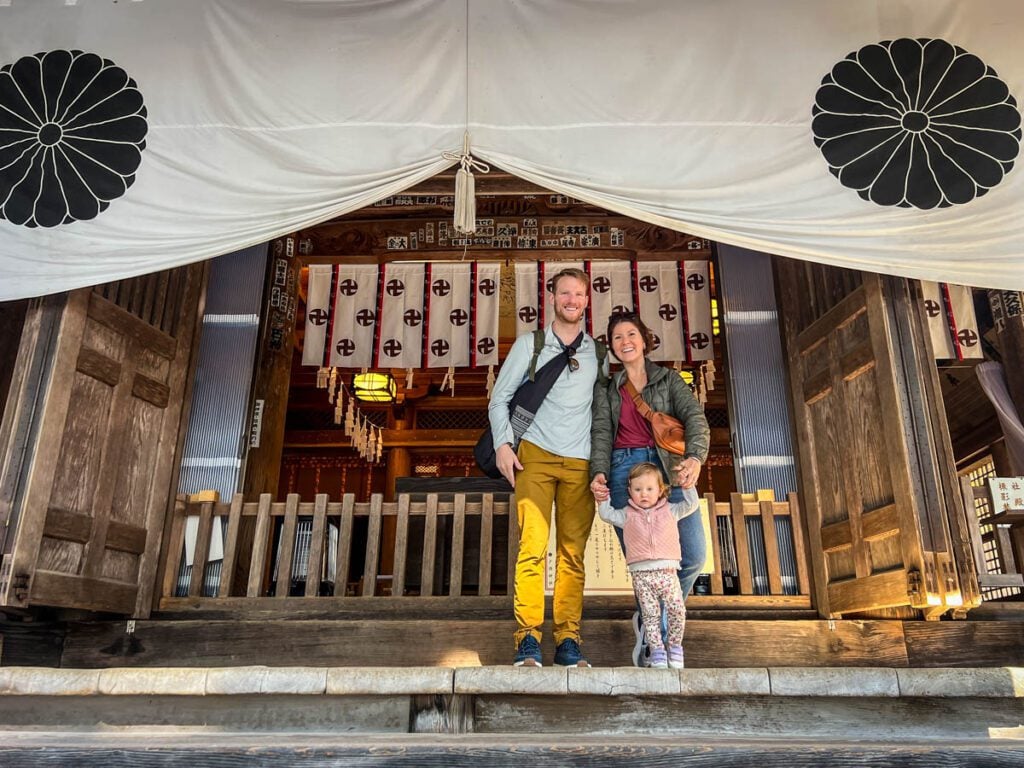
We’ve traveled to Japan several times, and brought our 2-year-old daughter along on our most recent trip.
This means that our personal experience applies specifically to traveling in Japan with a toddler.
If you have a baby or older children, there will still be plenty of good advice and tips in this article. Just keep in mind that our perspective is from traveling with a 2-year-old.
Spoiler alert: Overall, we had the BEST trip and are already planning a return trip to Japan with our little one in tow!
Tips for traveling in Japan with kids
Now that you have a pretty decent overview, let’s dive into the things you need to know about planning a family trip to Japan.
1. Pack light
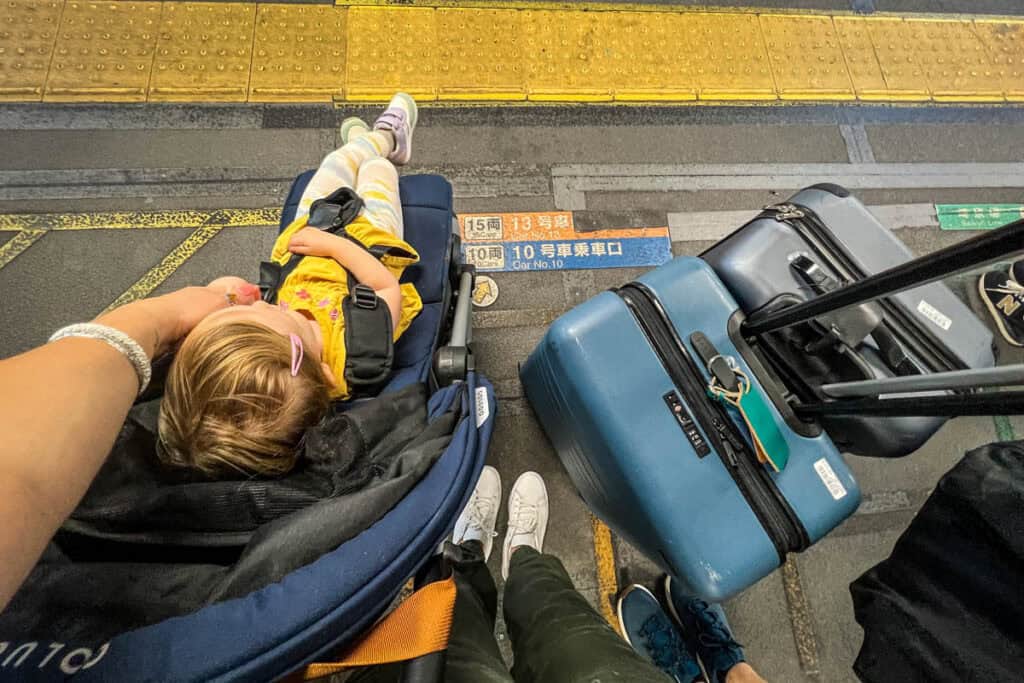
Like, light, light, light!
Once you know what bag(s) you’re going to bring, close your eyes and envision navigating trains and subways with your luggage AND your child at the same time.
If it feels stressful in your imagination, cut down the amount of things you’re going to bring, or choose a different type of suitcase. I cannot stress this enough. Japan is not a place you want to overpack.
Not only will you need to move around and navigate transportation with your luggage, but many hotel rooms (especially in big cities) are quite small. And if you plan on renting a car (more on that later), the trunks are very small in most vehicles in Japan.
Repeat after me…
I don’t need to pack very much for my trip to Japan. I will be so happy I packed light!
Remember this: You can buy many things in Japan if you forget something. Packing a capsule wardrobe and planning to do laundry at least once on your trip can help minimize the amount of clothes you need to pack.
Download our (free!) Japan packing list so you know exactly what to bring (and what to leave at home!).
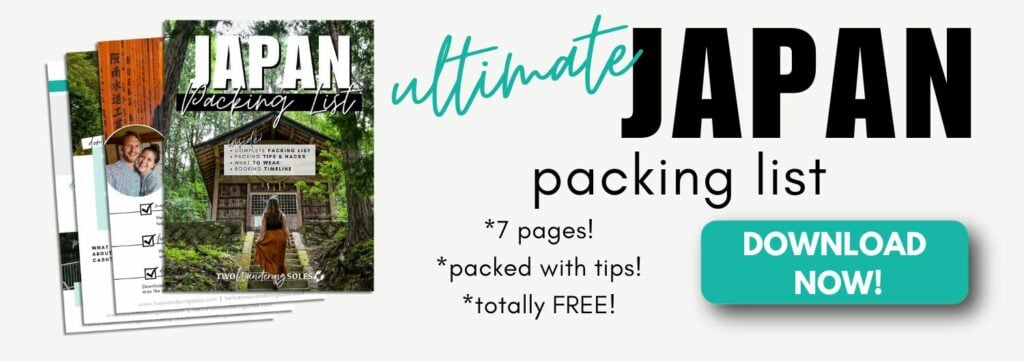
Our personal experience: We brought 2 suitcases (medium size Away luggage), each had a small backpack, and we also brought a compact travel stroller.
We think this was a good amount, and wouldn’t have been able to handle any more than this. Had we not been going to Thailand and Minnesota (in the winter) immediately after this trip to Japan, we would have packed even less.
One more tip: Make sure your suitcase has high quality wheels, as you’ll be walking around a lot with it and don’t want them to break or not roll easily.
Luggage transfer
You may want to consider using a luggage transfer service. We have personally never used this service (and likely wouldn’t do this unless it was a special circumstance).
- Pros: Your luggage gets transferred without you having to bring it on public transportation. This is a very reliable and efficient service in Japan.
- Cons: It can get quite expensive if you do this for your entire trip. Plus, it’s not possible to do this in many cities in Japan (just a few).
Personally, instead of relying on this service, we’d plan on just packing light!
2. Hotels often don’t have cribs
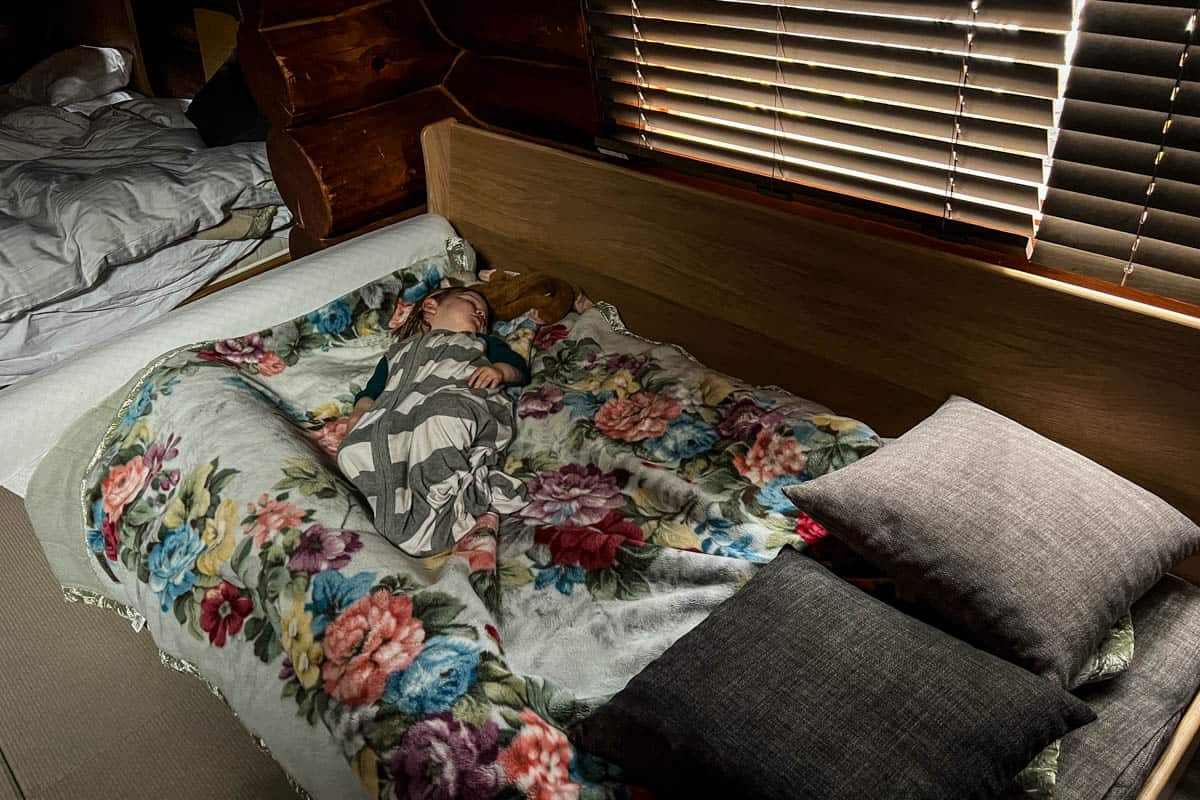
If you’re used to hotels with pack-and-plays, you’ll be disappointed to learn that most hotels in Japan do not have cribs available.
Cosleeping is pretty common in Japan, meaning that you’ll likely only find pack-and-plays available at luxury hotels, international chains, hotels catered to families, or the occasional outlier.
Our personal experience: We stayed at 8 different hotels in Japan with our toddler, and only one offered a pack-and-play free of charge. One Airbnb offered a crib for an upcharge, and one other hotel had a bassinet but it was too small for our toddler.
Instead of lugging around your own pack-and-play – I love our Guava Lotus, but I would never carry it all around Japan – we recommend embracing Japanese futon sleeping arrangements because it really does work so well with kids and will allow you to experience authentic Japanese accommodation.
3. Help your little one adjust to a new time zone
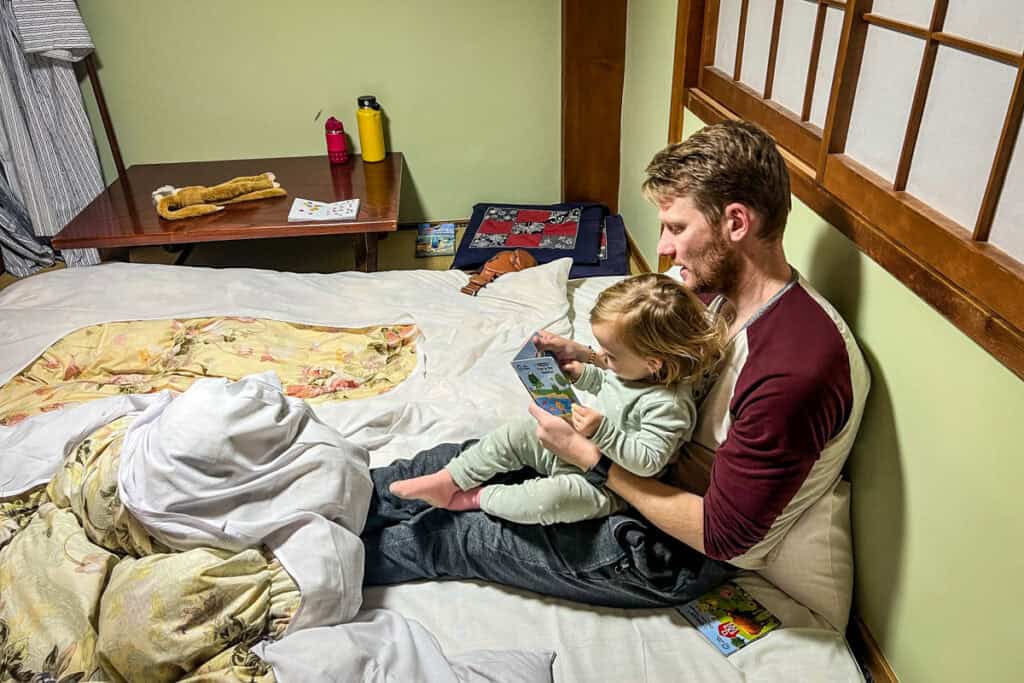
If you’re traveling from afar and will be going through a big time zone change, here’s a bit of advice:
a) Try to shift to Japan’s time immediately when you land
When you land, try your hardest to get everyone in your family as much on Japan time as possible. That means try to stay up until a reasonable bedtime hour. Eat when it’s meal time, even if you’re not super hungry.
Adults: Resist the temptation to take a nap. Children: Encourage normal naps if possible, but don’t stress too much about it.
You probably won’t get it all perfect, and don’t worry too much. These are just some things to aim for.
Good to know: The second and third days are often tougher than the first.
b) Use daylight to your advantage
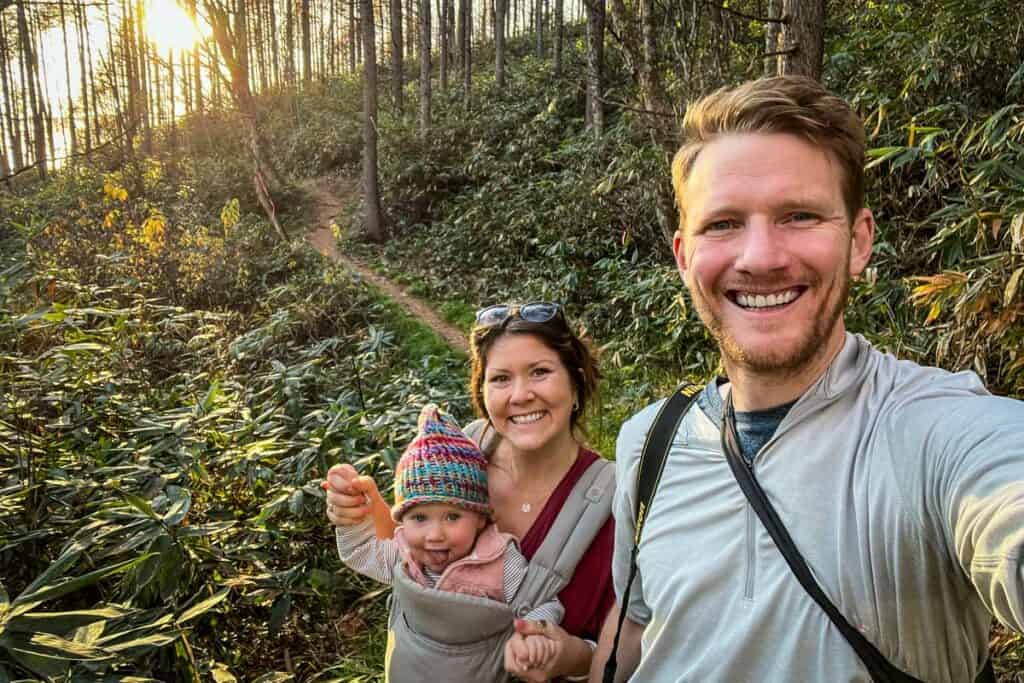
When trying to adjust to a new time zone, getting outside and making sure you’re in the sun can really help. Get out and do something active, like walk or go to a playground.
Your baby will realize this is daytime, and their body will start to adjust accordingly.
c) Start shifting time zones at home
Before you leave for your trip, start to shift bedtime 1-2 hours to get closer to Japan’s time zone if you can.
Start slow. A few weeks before the trip, make their bedtime 15 minutes later. Then 30, and so forth until you’ve shifted as much as you’d like.
You won’t get all the way, but it can help cut the adjustment time down once you get there.
d) Know that you don’t need to get back to your “normal” bedtime

Personally, when we’re traveling, we don’t worry too much about getting back to our exact “home bedtime”.
It usually works better for us if our daughter has a later bedtime when we’re traveling so that we can stay out later rather than be back at our hotel by 7 p.m. to start our bedtime routine.
This can mean that we don’t have to “jump” quite as many zones too, making the shift slightly easier.
If we end up adjusting her bedtime, we just want to be sure that she is getting the same number of hours of sleep, meaning she’ll sleep a little later in the morning, which can be good or bad depending on your travel plans.
Depending on your travel style and your priorities, this trick may or may not work for you.
e) Take care of yourself too
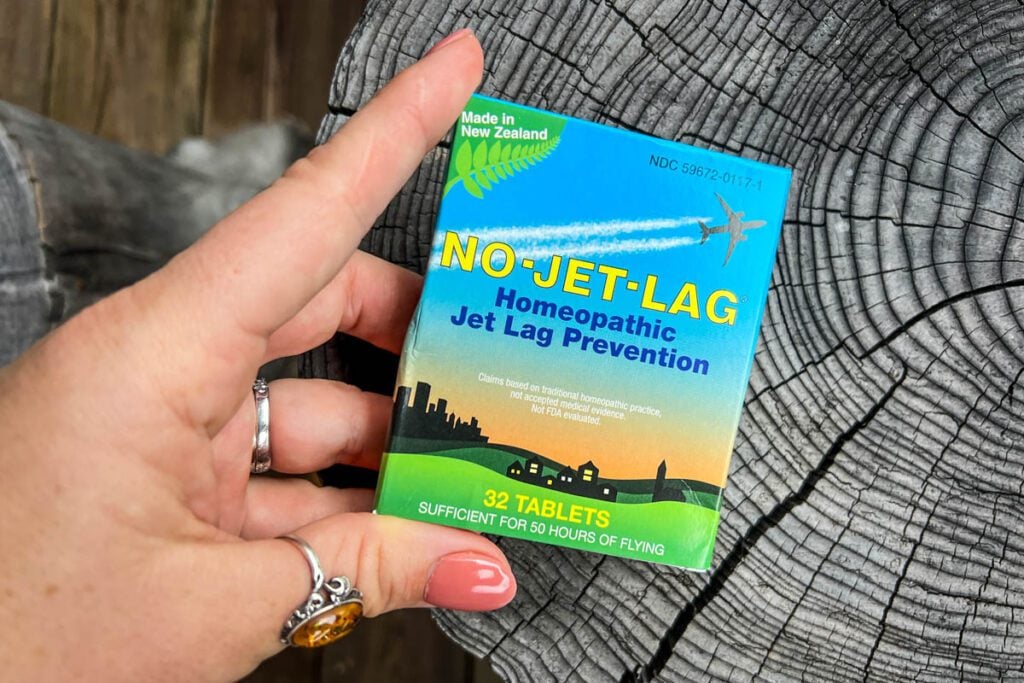
Not only is your kiddo adjusting, but you are, too. Honestly, the time shift was harder on us than it was for our daughter because she could still nap during the day and wasn’t in charge of getting anywhere (aka stress free!).
If you are well-adjusted, it’ll help both you and your child, so here are a few adult-only tips:
- We like these homeopathic “No Jet Lag” pills when we’re traveling through many time zones. These are for parents (not babies), but being adjusted yourself definitely helps deal with helping your little one shift as well!
- For the first few days, try not to have caffeine past the time you’d normally stop drinking it (even though it may be tempting).
- Try to avoid alcohol for the first day.
- Have a positive attitude, as this will rub off on your kiddo and will set the tone for all of you. Have realistic expectations and remember that your excitement will rub off on them.
f) Don’t stress too much
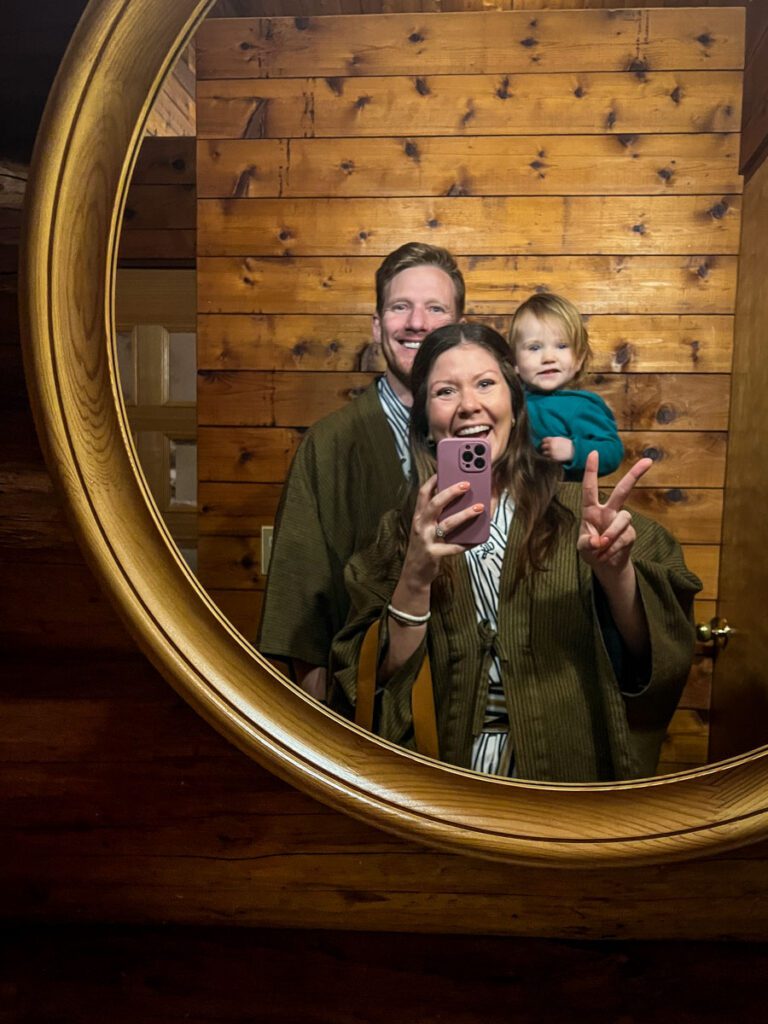
I know this can be a huge worry for many parents, especially if it’s their first big international trip as a family. Kids are more resilient than we often give them credit for.
Expect the first few days to be a bit of a challenge, and plan your itinerary accordingly. But the new daylight hours and mealtimes will definitely help reset their rhythm.
4. Put some extra thought into your itinerary
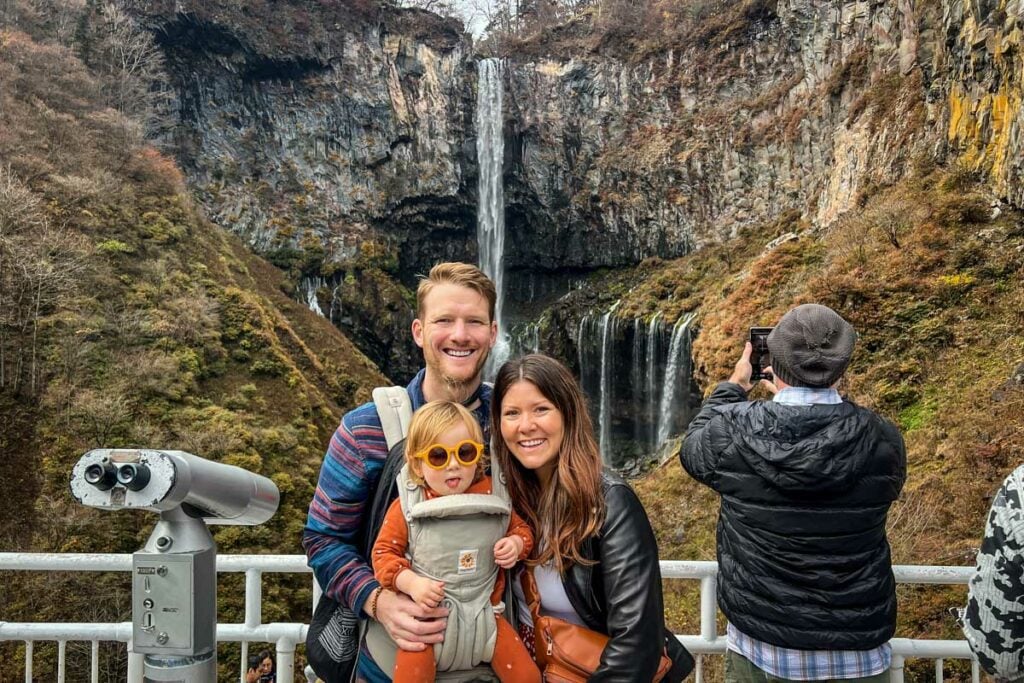
If you’re traveling in Japan with children, you’re going to need to put a little extra thought into your itinerary.
There are certain activities that aren’t well-suited to a family trip to Japan (jump down to see which ones I’m talking about). Plus, you’ll want to move more slowly than if you weren’t traveling with kids.
I’d also put some thought into the specific destinations you’re visiting and the experiences you’re prioritizing.
If you want some help with planning your route, we have two incredible Japan itineraries that are ready to go. All you have to do is pack your bags!

Choose from a classic route or a hidden gems itinerary. We went to many of the destinations on these itineraries with our toddler, so they are a really great resource for planning a family trip and will save you a ton of time.
5. Breastfeeding in public isn’t very common
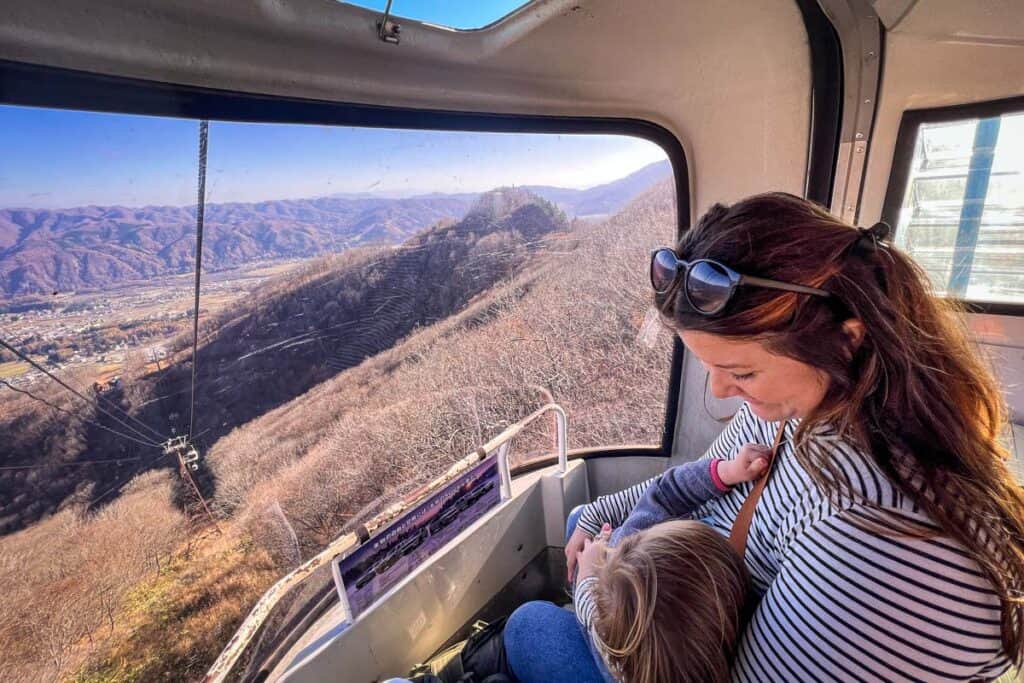
I’ve read that the majority of mothers in Japan breastfeed their babies, but before our trip, I heard murmurs that nursing in public isn’t very common.
I was still breastfeeding our then-2-year-old, so I made sure to pack a nursing cover (even though I hadn’t used it since the newborn days at home).
There are some nursing “pods” and lactation rooms scattered throughout the train stations in Tokyo (and other big cities in the country).
You can find these lactation rooms and diaper changing areas on the app MamaPapaMap.
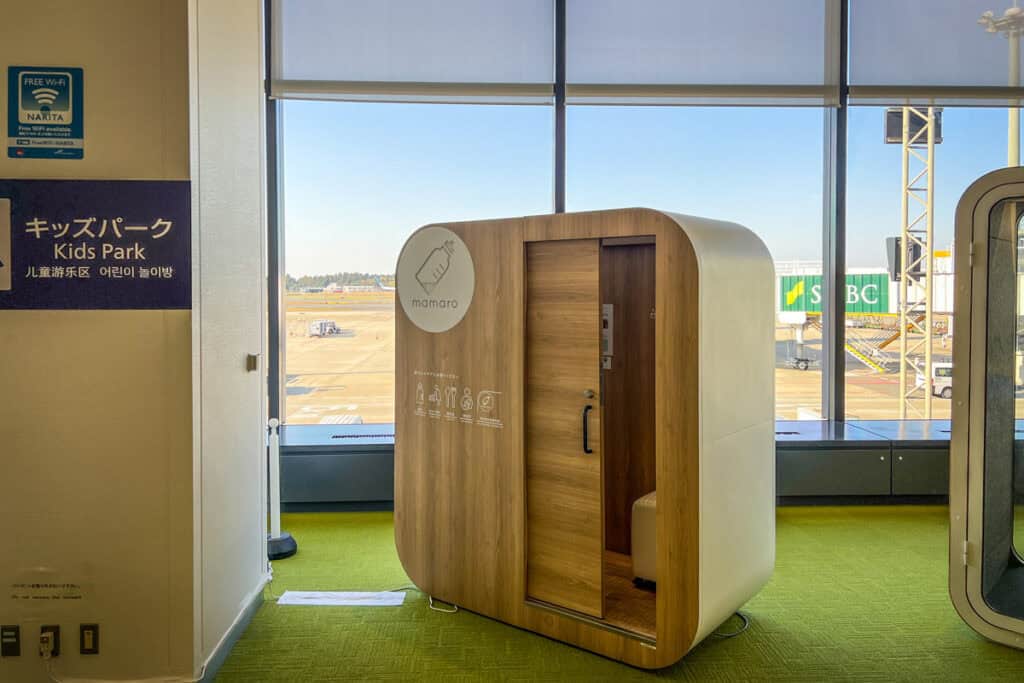
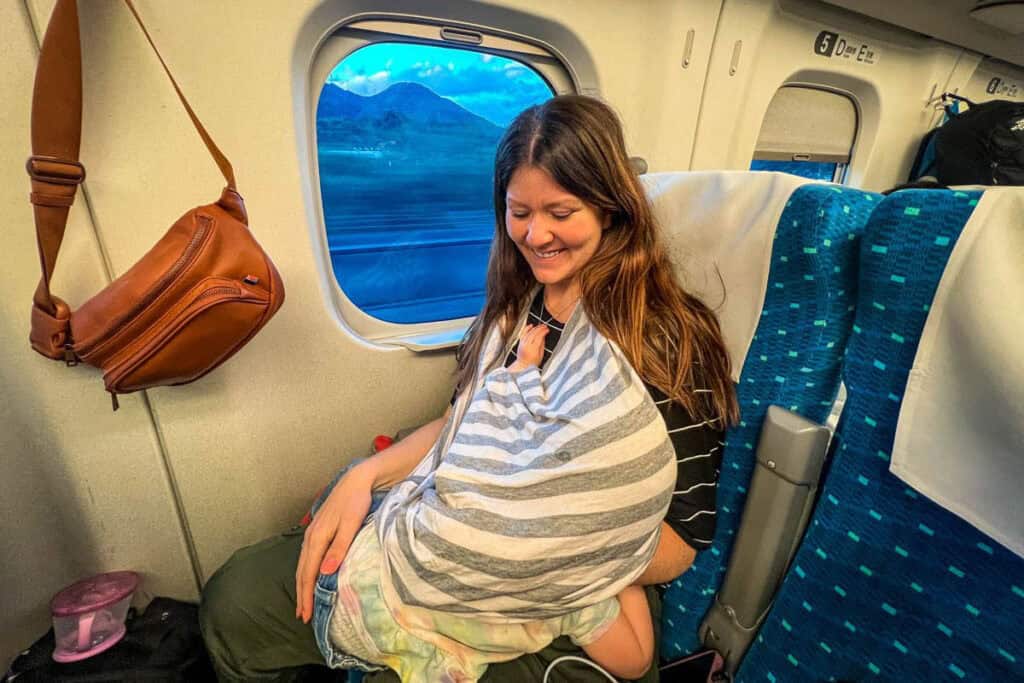
The thing is, in our experience, these lactation rooms weren’t always accessible or convenient during the times my daughter wanted to nurse.
For this reason, I was really happy I had my nursing cover so I could feed my daughter while on long train rides or to break up a long day of walking.
6. Bathrooms are child-friendly and they are everywhere
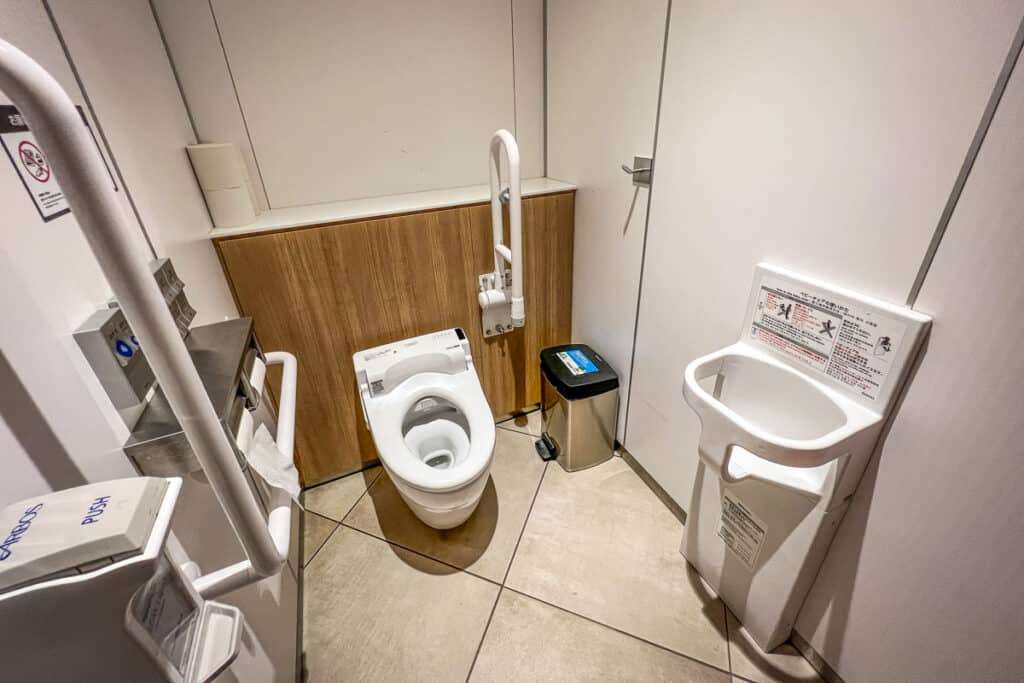
We found it to be quite easy to locate public bathrooms in Japan, as they are almost always free to use and can be found in most train stations, convenience stores, tourist attractions, department stores, playgrounds, and parks.
In general, bathrooms in Japan are clean and stocked with toilet paper, but we found hand dryers or paper towels pretty rare.
In addition to being generally nice, public bathrooms in Japan are almost always child-friendly. We found that both the mens’ and womens’ restrooms had changing tables, and often had a stall with a seat where you could buckle your child in while you do your business!
Our personal experience: If you’re in dire need of a diaper change and can’t easily find a public bathroom, head to the nearest train station.
This happened to us once and we spoke with one of the train attendants (using Google Translate). He let us into the station (without having to pay for a ticket), and brought us to a private lactation room.
7. Know this about getting diapers in Japan…
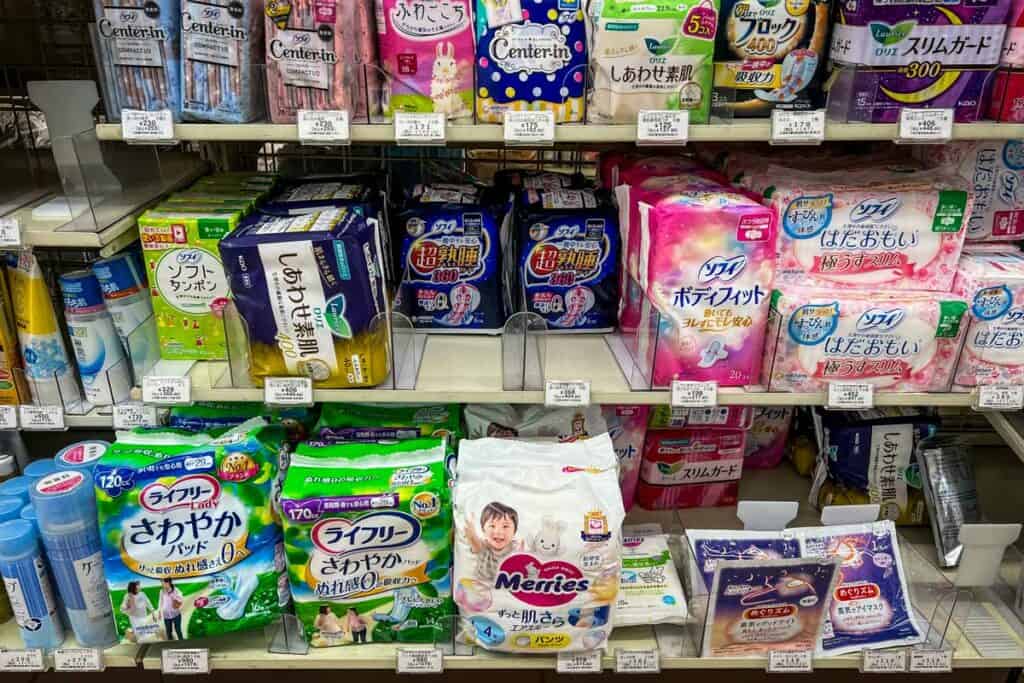
When traveling somewhere for more than 5 days or so, we always plan to stock up on diapers at the destination instead of bringing a supply for the entirety of our trip. Bringing 2-weeks worth of diapers would take up an entire suitcase, after all!
Children live everywhere in the world, meaning you can find diapers everywhere, right?
Well, we had a heck of a time finding diapers in Japan because we didn’t know where to look.
We went to several convenience stores. No diapers.
We went to a couple of supermarkets*. Still no diapers.
We found ourselves kind of nervous, as our supply was dwindling fast. Then, we realized that diapers are most often sold in pharmacies in Japan.
Look for a green plus sign symbol, or search “pharmacy” or “drug store” in Google Maps.
Boom, problem solved! Now you won’t need to waste any time (or freak out unnecessarily!) searching for diapers, like we did.
One more thing to know about diapers in Japan: The only ones we could find in the size we needed (4) were “pull-up” style. I imagine that the smaller sizes come in the “tape” version, but in three weeks, we didn’t find any of that style for our 2-year-old.
The pull-up kind ended up being fine once we realized you could rip it open (and therefore don’t need to take off their shoes and pull down a big messy diaper!).
*I believe that some supermarkets sell them, but in our experience we had better luck with drug stores.
8. Bring (some) snacks from home
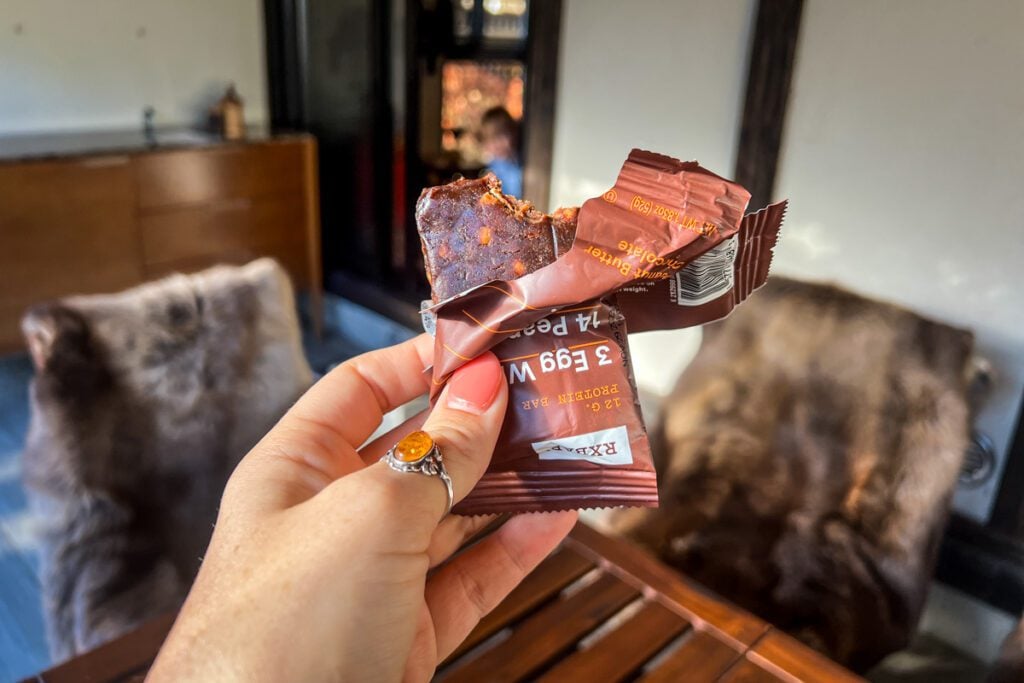
Japan has amazing food, and there are some great options for kiddos (more on that later); however, we recommend bringing some snacks from home as well.
Here’s why:
- Your little one will be going through lots of changes, so having a couple of “comfort foods” you know they like will make things easier on you both.
- It’s nice to have some options for your first several days so you don’t have to worry about getting food right away.
- The space used to pack these items can then be reserved for carrying souvenirs home. Win-win!
- While we found some good items, there were some things that were hard to find healthy versions of in Japan.
- Pouches: these don’t seem to be super common in Japan and the ones we did find were a jelly-like consistency and had sugar as a top ingredient. If your child is big on pouches, I’d recommend bringing your own.
- Crackers or puffs: the crackers and puffs we typically get at home come in all sorts of healthy-ish versions, with a blend of grains, seeds, vegetables, protein, etc. However, the ones we found in Japan tended to be more traditional crackers with wheat, oils, and sugar as top ingredients. If you want a healthier option, bring some of your favorite brands along and supplement with what you’re able to find in Japan.
- “Melts”: We personally didn’t see much when it came to freeze-dried fruit “melts”, so we were happy we packed some of our own as a little treat.
All this said, don’t go too crazy on packing food. While it might be different from what you’re used to, you will be able to find options in Japan.
In the next section, we’ll talk about snacks you can find at convenience stores. And for options at restaurants, jump down to this section on Japanese foods that are kid-friendly.
9. Convenience stores are everywhere
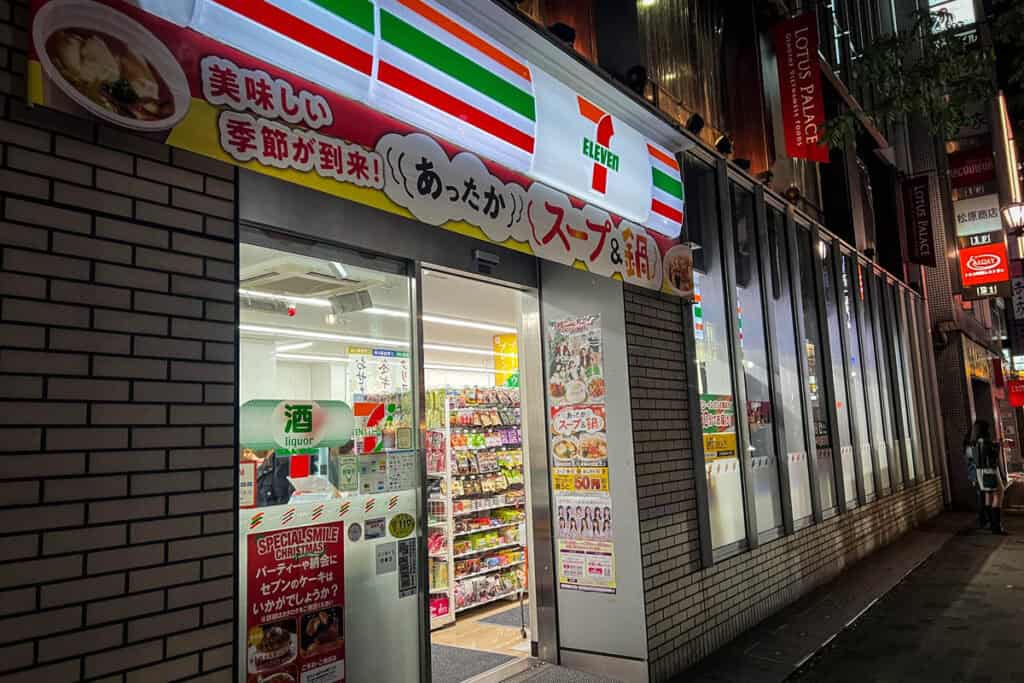
Convenience stores, or konbini, will be your savior when traveling in Japan with a toddler.
They are truly everywhere around the country, from rural villages to all the major cities. You won’t be able to go very far without seeing one. In fact, many streets in Tokyo and Osaka have several konbini on a single city block.
The big names are 7-Eleven, FamilyMart, and Lawson, but you’ll discover more too.
These are all one-stop shops for basically anything you need: an ATM, snacks, coffee, toiletries, hot food, you name it!
Convenience stores are typically open 24/7, so even if your child is jet lagged and “needs food now!”, you should be able to get what you need.
Toddler-friendly konbini foods
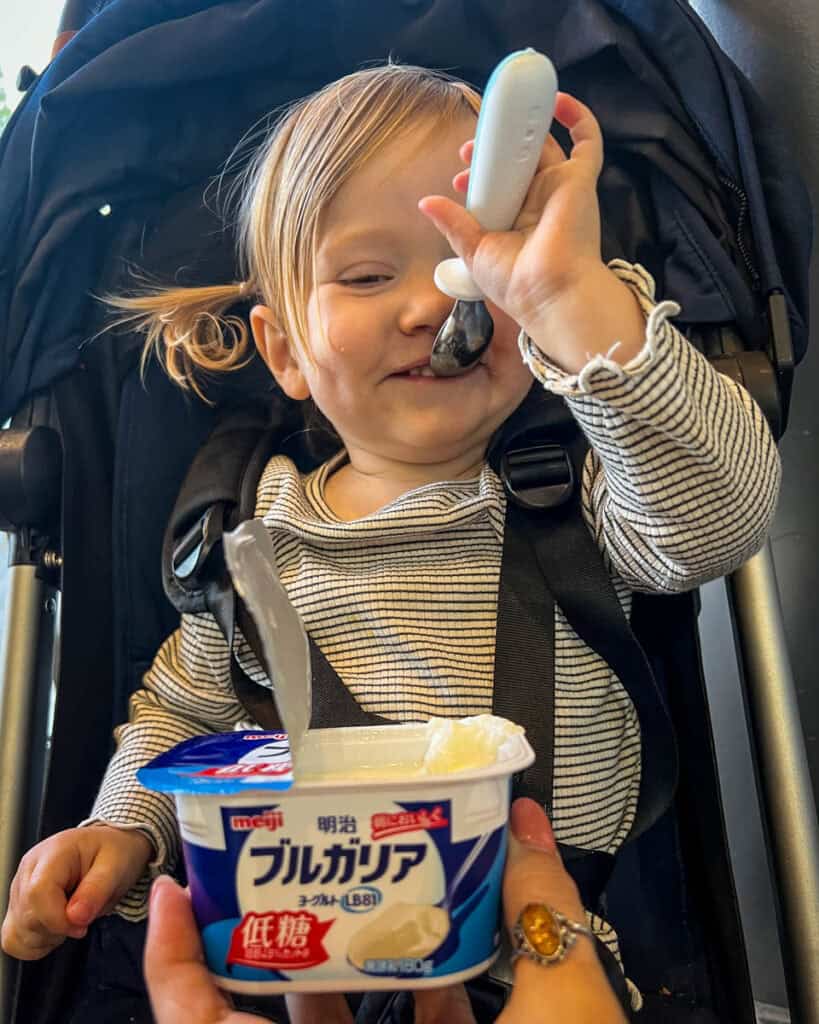
Here are some of our go-to food konbini items that worked well for our toddler:
- bananas
- string cheese
- crackers
- yogurt (we preferred the Greek, unsweetened style because that’s what we eat at home, but there’s a variety)
- imitation crab sticks
- pastries
- sandwiches
- onigiri (rice balls stuffed with fillings)
- dorayaki (pancake with red bean paste filling)
- hard boiled eggs
- fresh vegetable cups
- bento boxes
- kaarage (fried chicken)
- gyudon (rice topped with beef and onions in a sweet soy sauce)
- soba noodles
10. Breakfast options are limited
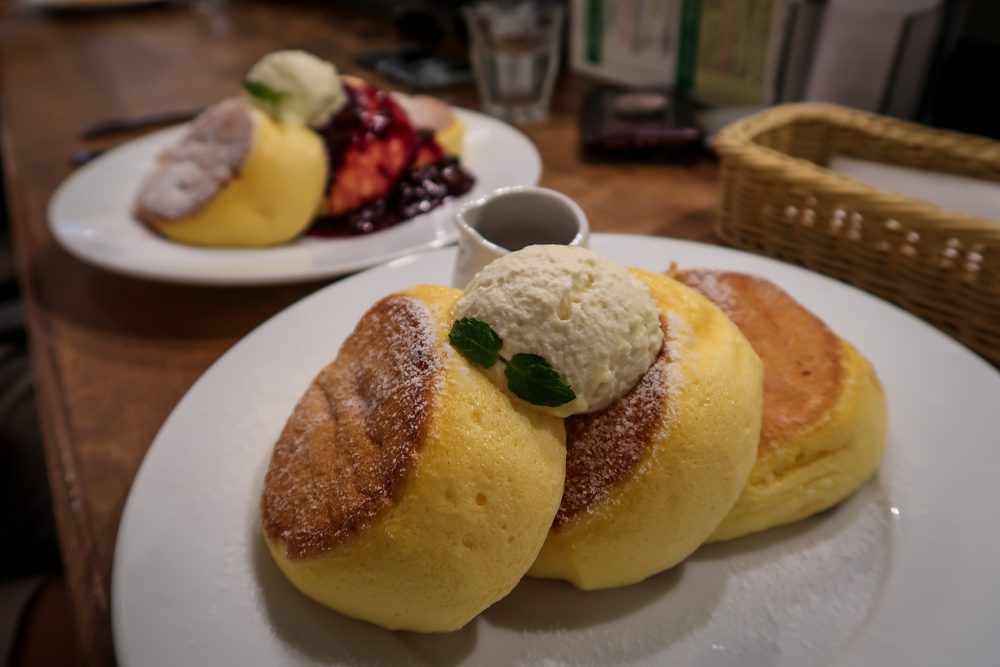
If you and your family are big breakfast eaters (like we are!), I’ll be the first to tell you that breakfast in Japan is going to be a bit of an adjustment…
First, breakfast foods in much of Asia (including Japan) aren’t what Westerners think of as typical breakfast fare.
Instead of eggs, pancakes, and fruit, traditional Japanese breakfast consists of rice, soup, fish, and other dishes that Westerners would typically associate with lunch or dinner.
Secondly, finding places that are open early for a proper breakfast can be a bit challenging, especially outside the major cities, as eating out for breakfast isn’t quite as common in this part of the world (though that is certainly changing).
All this said, you certainly can find breakfast in Japan as long as you know where to look.
Where to get breakfast in Japan
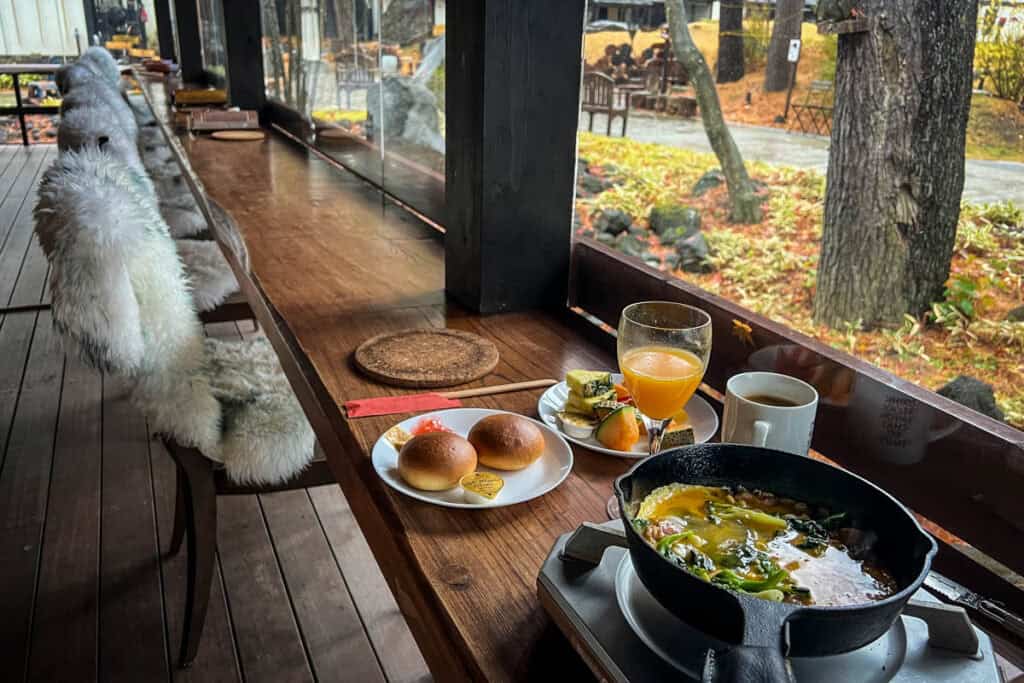
Here are some options:
- Coffee shop chains near train stations are going to be your best bet for getting coffee in the morning as they are usually open by 7 or 8 a.m. Some of these chains also serve “breakfast sets” which sometimes include a pastry or an egg sandwich of some sort (egg salad is big in Japan). To find one that is open early near you, type “coffee” into the search bar of Google Maps.
- Get a Japanese-style breakfast at Matsuya, a popular nationwide chain that locals frequent. They serve meals all day, and some locations are even open 24/7. Breakfast is typically served from 5 a.m. to 11 a.m., and you can order from a machine or app. There are different set meal options, like a Japanese style breakfast with salmon, rice, and soup, or a Western-style egg and sausage set.
- Go to a trendy brunch restaurant. In major cities you’ll find a handful of brunch restaurants, many of which serve things like the Instagram-famous fluffy souffle pancakes. Often, these restaurants don’t open until 10 a.m. or later and have a queue, so sometimes they don’t work super well with children. An alternative option is looking for a Western restaurant; however, I wouldn’t count on having wonderful food.
- Book hotels with breakfast. Many hotels in Japan have the option to add breakfast, and depending on your itinerary and needs, this can be a good idea. I would recommend reading through the reviews and filtering ones that mention “breakfast” to get an idea of what it includes. Some have a wonderful buffet while others are very basic and not worth the additional cost. Also, you may want to know if it is Japanese style breakfast (we recommend trying it at least a couple of times!) or Western style. FYI If you stay at a ryokan in Japan, it is a good place to try a Japanese style breakfast.
- Pack your own “backup” breakfast. We often travel with a bag of oatmeal mix for days when it’s hard to find breakfast. We know that our daughter likes it and we feel good about her getting a nutritious breakfast even if the options are limited. All we need is a water boiler, which should be in every room in Japan. You could bring individual packets if you like, or you can make a healthier mix like we do (recipe below).
- Our oatmeal recipe: organic quick cooking oats, coconut milk powder, chia seeds, freeze dried fruits, cinnamon, powdered peanut butter, a little bit of coconut sugar and/or monk fruit. We pack it all in this bag and take servings out as needed.
- Buy some convenience store items. When all else fails, head to the nearest convenience store (they are never too far away!) and pick up items like bananas, yogurt, or pastries for a quick breakfast.
11. BYO coffee maker
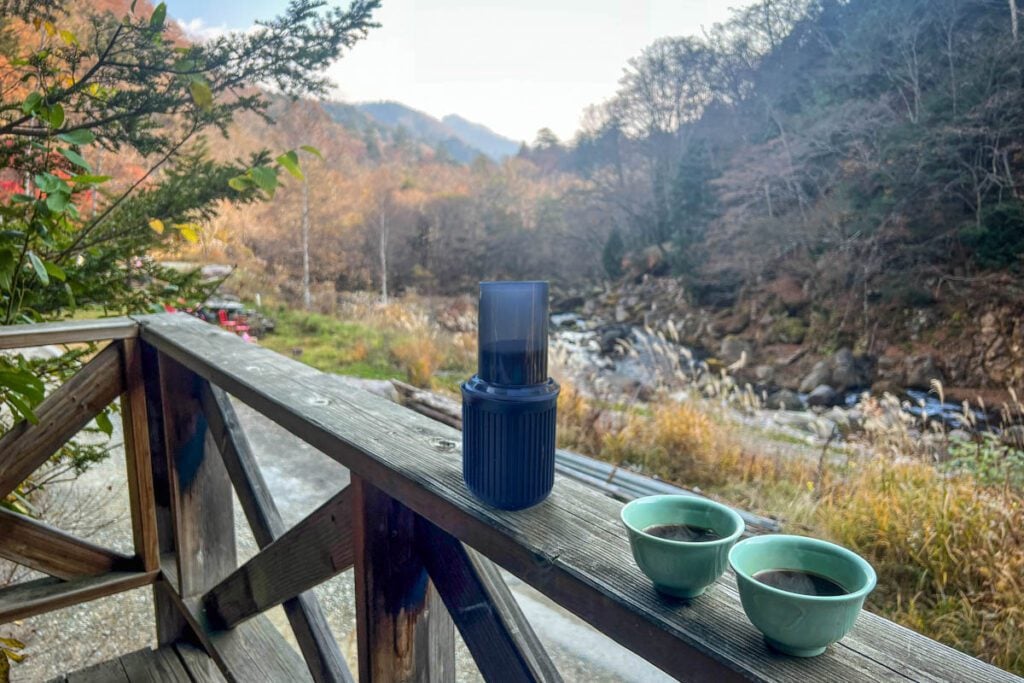
If you’re a coffee-lover like us, don’t sleep on packing this item! Caffeine can be a necessity when traveling with a little one, after all.
While Japan’s coffee scene is quickly growing in popularity and you can find some excellent cafes around the country, many don’t open until 10 a.m. or even later.
If you like to start your morning with a caffeine boost, it can be hard to find a coffee shop that is open early.
We love our travel Aeropress because it is super compact and makes excellent coffee.
Our personal experience: With the exception of one hotel and one Airbnb on our most recent trip, no other accommodations had coffee makers. We were so happy we packed our travel Aeropress because it got lots of use on this trip!
Tip: If you don’t end up packing a coffee maker but are in need of a morning boost, your best bet is to look for a coffee shop chain near a train station, as they tend to be the ones open earliest.
12. Almost all restaurants have child plates/utensils
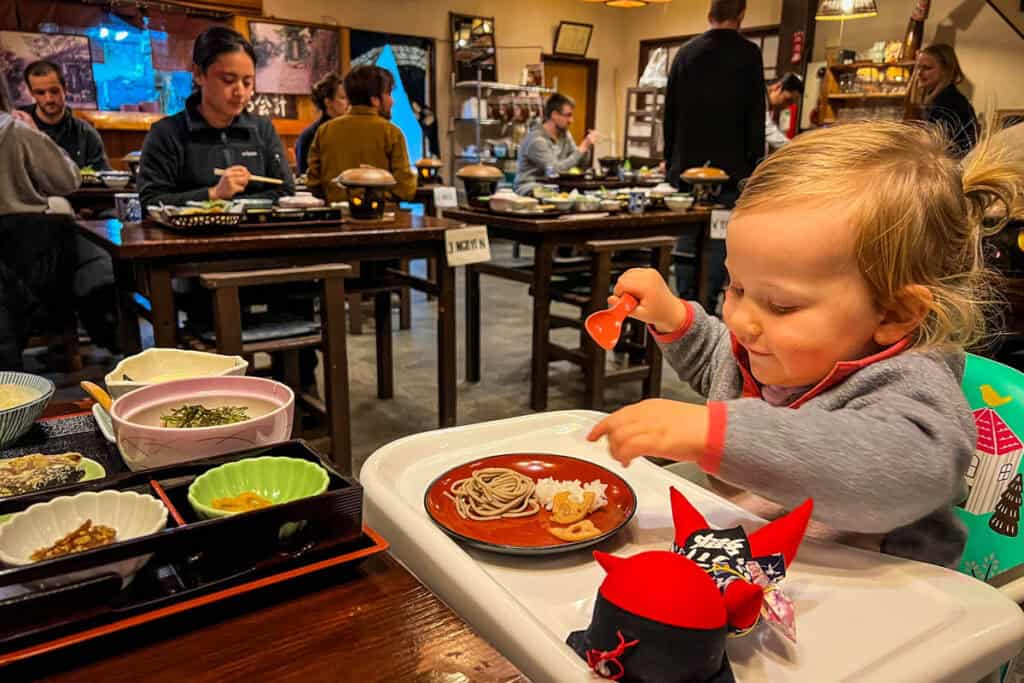
A pleasant surprise to us was that just about every single restaurant we dined in had special utensils and plates for children.
We ate out for almost every meal during our 3-week trip, so that’s a lot of restaurants! And we didn’t specifically choose restaurants that are “child friendly” – many of them were small, authentic hole-in-the-wall restaurants, and still they had items for children.
This is not often the case at restaurants in the US, unless you are at one that is specifically child-friendly.
This means we usually carry a small bowl and utensils for her so we don’t have to worry about the breakable dishes and adult-sized silverware that we’re often given. We hardly used those items in Japan, so next time, I’ll leave them at home to save space.
13. Prefectures have mascots
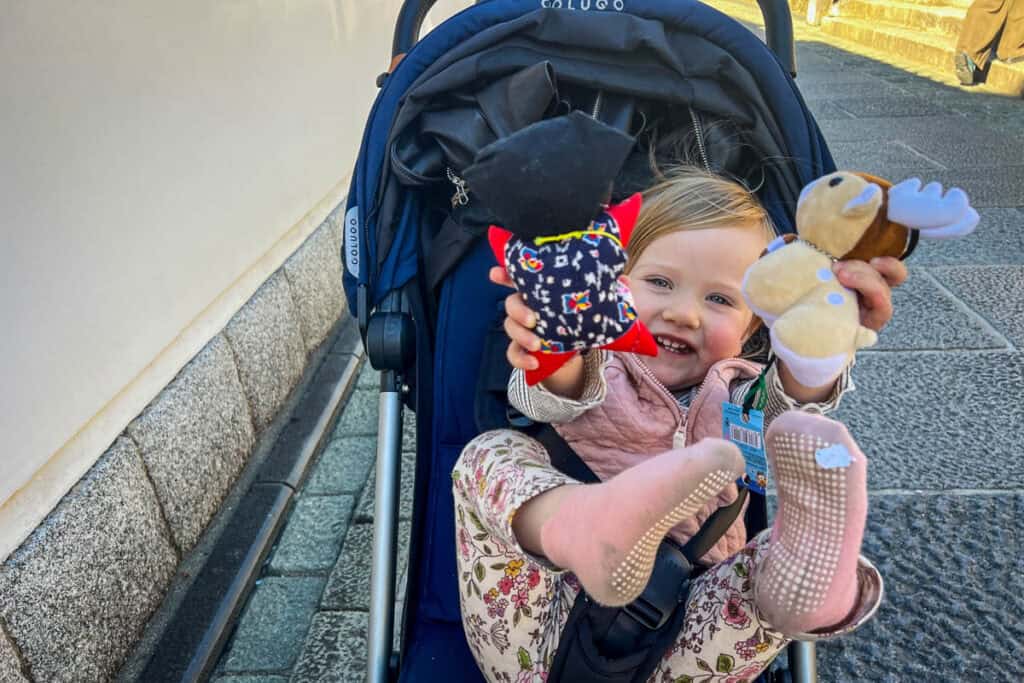
Japan is divided up into regional prefectures, each of which has its own tourism board, foods and attractions they’re known for, and mascots!
In true Japanese fashion, there is a cute character that represents each prefecture, which can be kind of fun to look for and point out to your little one, especially if you’ll be in more than one region during your trip.
Make it a scavenger hunt!
Hint: You should be able to find the mascots on signs, at train stations, and even for sale in stuffed animal form at some supermarkets (could be a cool souvenir from Japan for your kiddo.)
14. Stroller vs. carrier
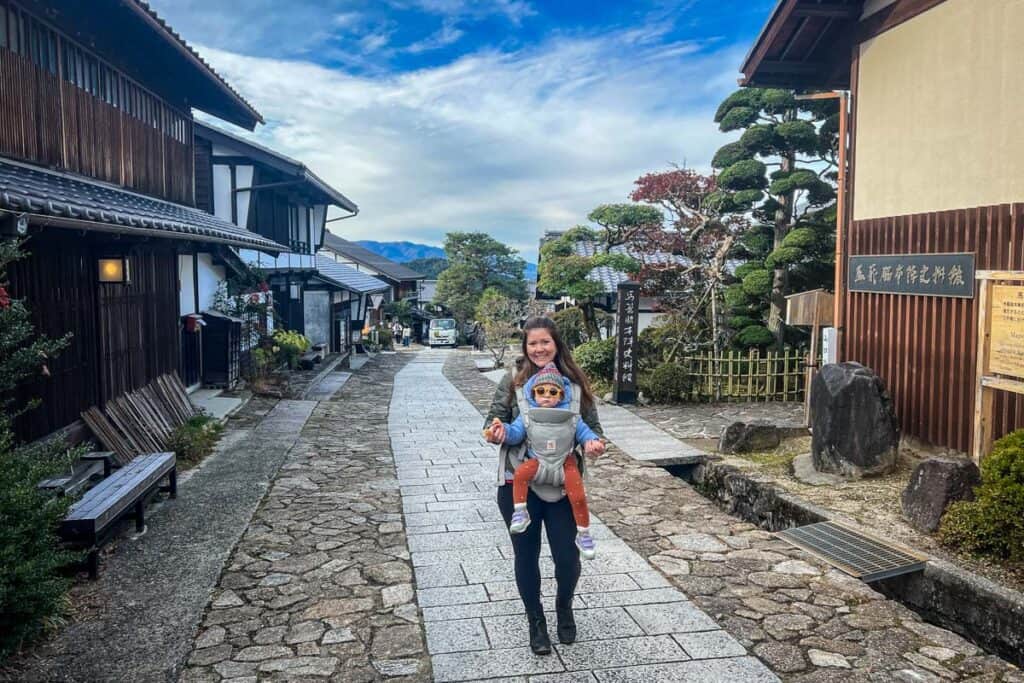
If you’re traveling with a baby or toddler, one question you’ll likely have as you’re packing is whether to bring a stroller or a carrier.
My advice: Bring both.
They each have their pros and cons, and there are certain situations where a stroller is clutch and other times when a carrier will work much better.
Before I jump into the pros and cons of each, I highly recommend that you are very selective with the type of carrier and stroller you choose.
They should both be ultra compact.
- This is the exact travel stroller we took to Japan (plus 14 other countries)
- This is the super versatile baby carrier we swear by
Stroller in Japan
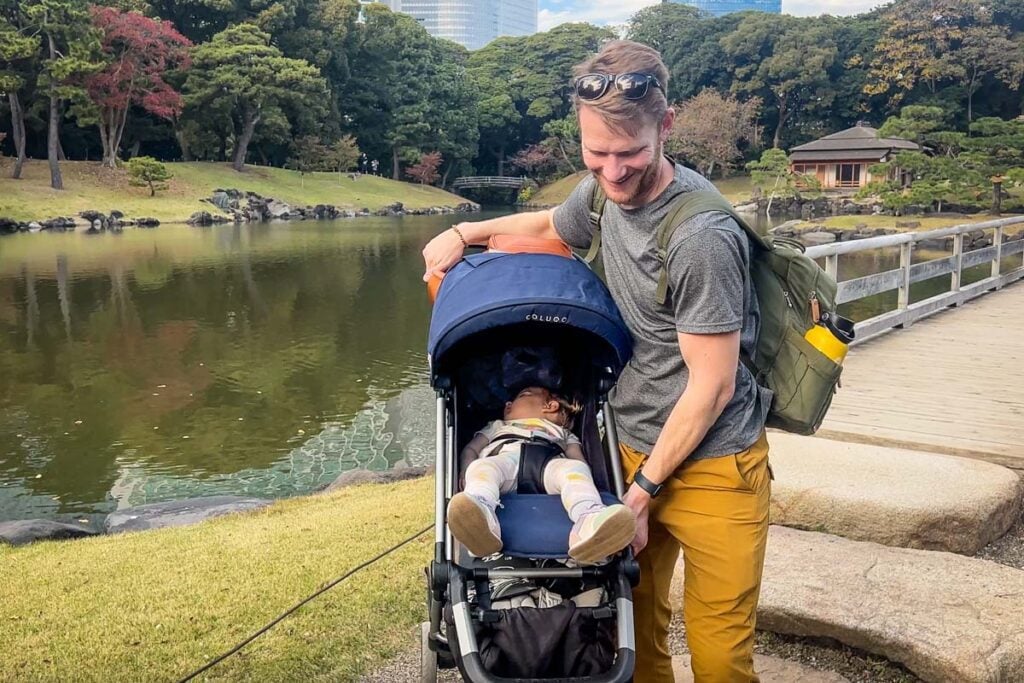
- Most days, you’ll be out and about over nap time. This is when a stroller comes in incredibly handy. Be sure yours reclines fully and has a shade.
- A stroller with a storage basket underneath is wonderful for carrying souvenirs and snacks that you’ll likely pick up as well as any essentials you’ll need during the day.
- My advice: Get a diaper bag fanny pack (like this one!) that you can sling over the handles. This is so much less bulky than carrying an actual diaper bag.
- You will be walking a LOT in Japan (trust me). Even if your little one walks some of the time, they will likely need a break eventually.
- If you’re traveling during the summer months when Japan is extremely hot and humid, you definitely will want to minimize the amount of time you are using a child carrier (which will make you even hotter and sweatier).
- Tokyo and many other big cities are pretty well set up for strollers, and navigating should be straightforward.
Baby carriers in Japan
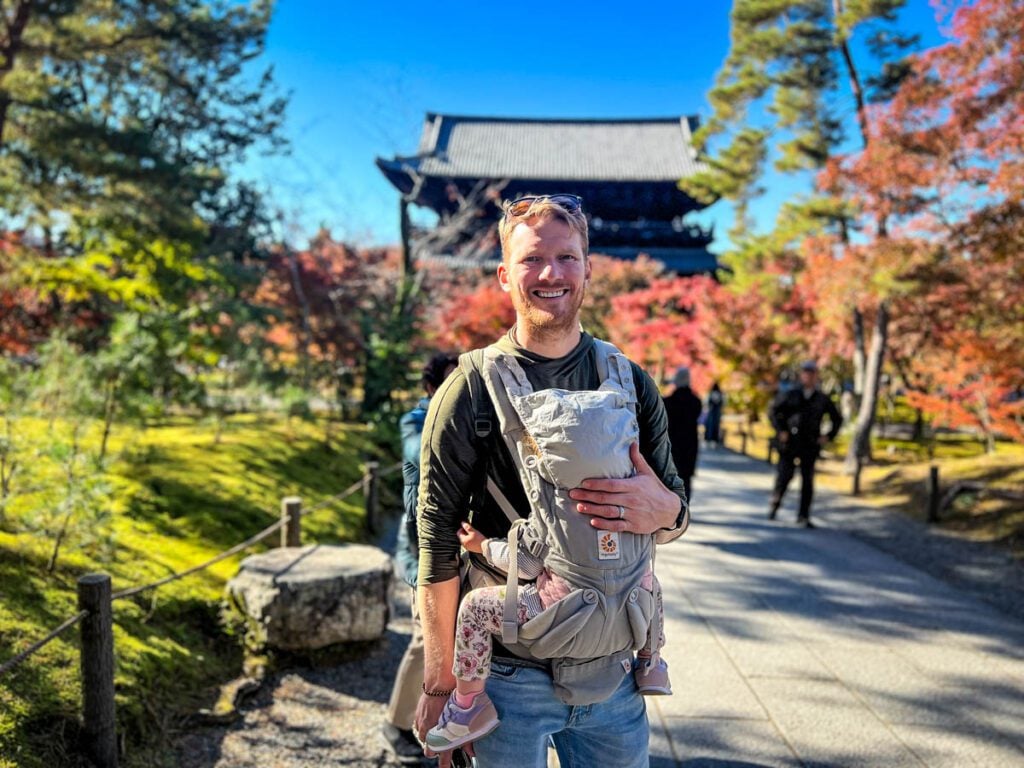
- Stairs and cobblestones mean some smaller cities or historic districts are not very stroller-friendly.
- If you’re planning on doing any hikes or walking routes, a carrier will be essential.
- For example, you cannot bring a stroller on the hike at Fushimi Inari (there’s a stroller “parking lot”), so a carrier is a must.
- Another walking route where a carrier is very handy is the Nakasendo Trail.
- When exploring busy and compact places, like the iconic Nishiki Market in Kyoto, Omoide Yokocho in Tokyo, or Tsukiji Market in Tokyo, a stroller is very big and bulky. A carrier will work much better in this situation.
- There were a few times where we left our stroller parked in a safe space and switched to the carrier. Japan is very safe and we never worried about leaving our stroller unattended for a while.
- Some temples and shrines are much easier to explore with a carrier as stairs are common. Many have stroller parking areas.
15. Navigate the subway with a stroller using this hack
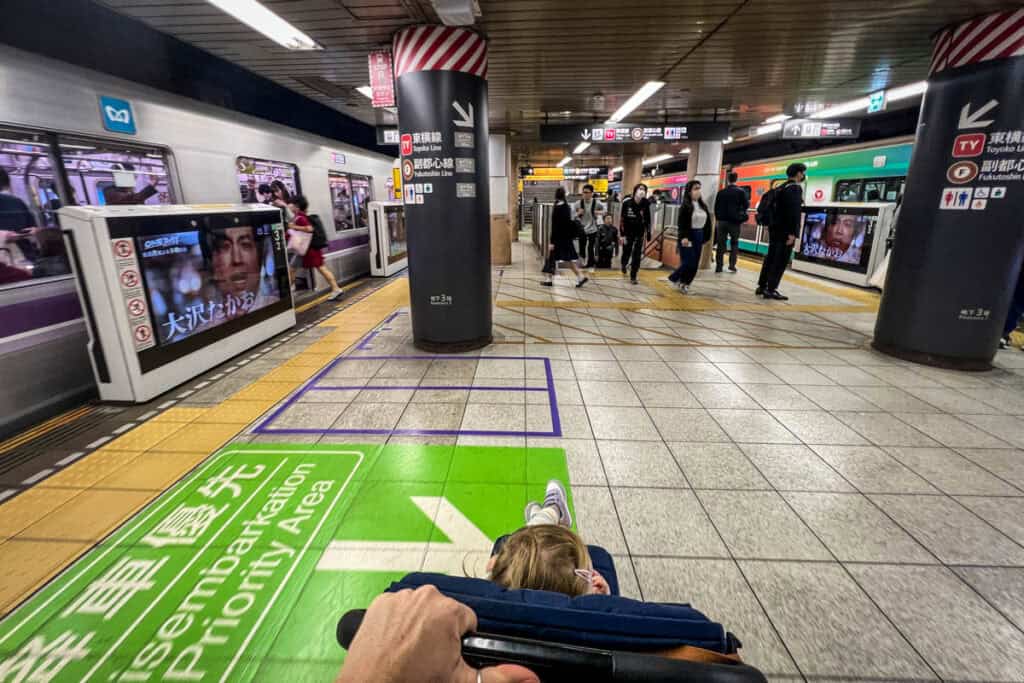
The public transportation system in Japan is pretty well-suited for strollers, and there are usually elevators or escalators.
If you have a stroller, the best way to navigate the subway system is to turn on the “wheelchair accessible” feature on Google Maps.
How to do this:
- Open the Google Maps app
- Type a place in the search bar
- Click the blue “directions” button
- Choose a starting point
- Click the three dots in the upper right-hand corner to open the drop-down menu
- Select “options”
- Select “wheelchair accessible” from the choices beneath “route options”, which will help you avoid stairs and bring you to elevators when available
This will reroute you to the entrances and exits with elevators as much as possible. It also can help outside of public transportation, as you’re navigating city streets.
In addition to using Google Maps, subway stations should also have a map posted where you can see icons for elevators.
Getting on a subway with a stroller
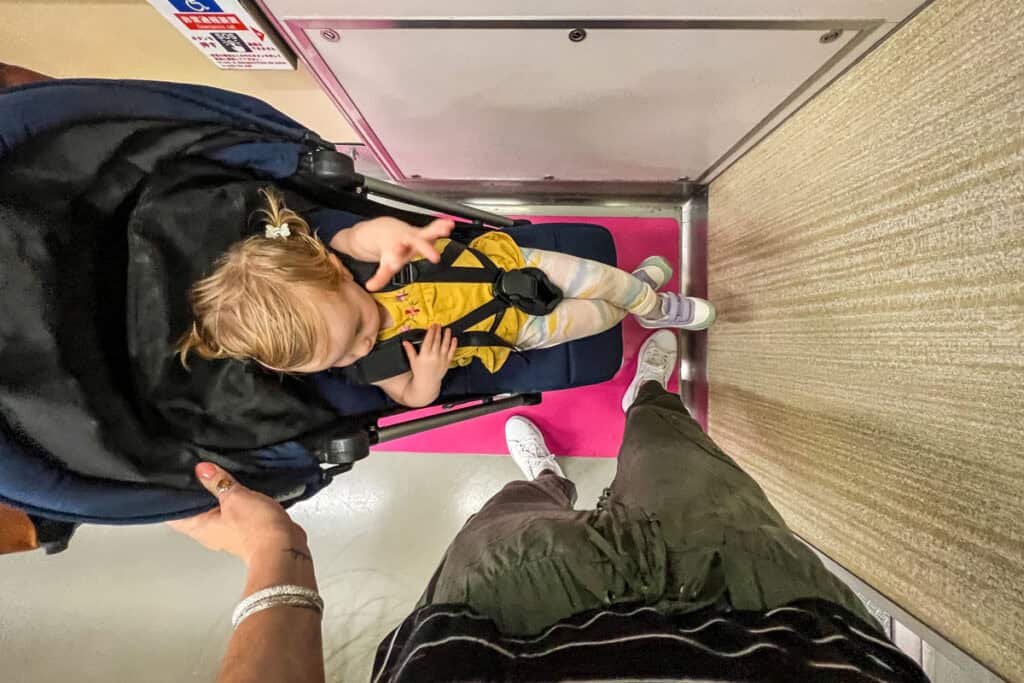
When you are getting on the subway, look for the car that has a “priority seating” label or a wheelchair icon, as they have an open section where you can stand with your stroller. Just be sure you lock it before the train starts moving!
Escalators with a stroller
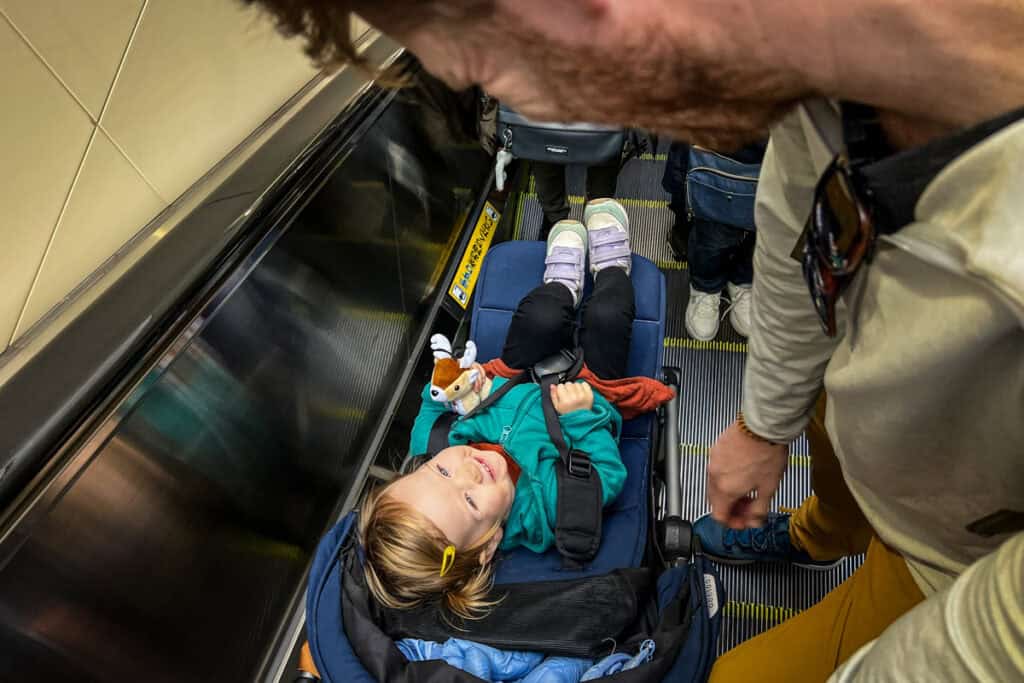
We also went up and down escalators quite a bit, which we’re very comfortable with now, but it took some practice.
When you’re going up the escalator, position the stroller backwards as you’re getting on. When going down, position the stroller forward and put weight on the handle to lean it back towards you a bit.
Carrying your stroller
All this said, there will almost certainly be some times where you will have to carry the stroller (either with your little one in or out). Practice this at home so you’re not in a high stress situation your first time!
16. Be extra mindful about choosing hotels
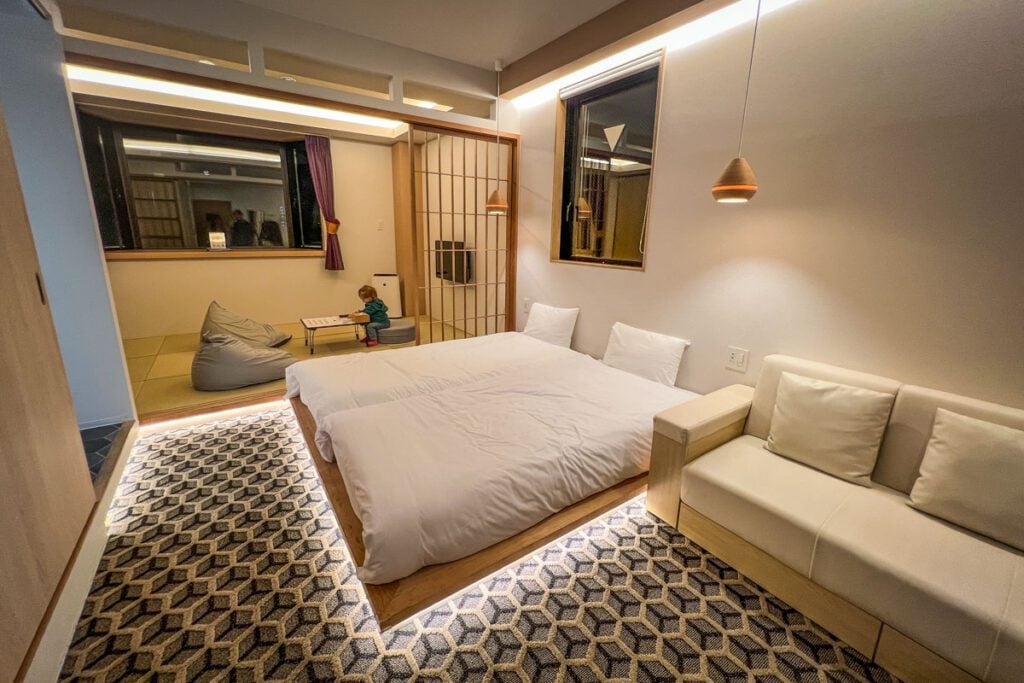
Japan has some of the coolest accommodation options in the world.
From traditional ryokan stays to capsule hotels to luxurious resorts to cozy cabin-style Airbnbs, there truly is something for every type of traveler.
I think most types of accommodations can work with children (with the exception of capsule hotels), but there are some things you may want to consider:
- Look into apartment-style hotels in the bigger cities, as these will often have more space than traditional rooms.
- Tip: The Mimaru chain is a really good place to start looking. We heard about them via Jo from The Tokyo Chapter and we were super impressed with our gigantic room in Tokyo! She also recommended this hotel in Kyoto (pictured above), which was very spacious and comfortable for a family.
- You may want to stay in a more “local” feeling neighborhood in Tokyo so that you can have more space. We found the best budget-friendly and decently-sized options in Akasaka.
- Psst! We have a guide to Tokyo neighborhoods that can help you decide where to base yourselves.
- Read the fine print and make sure children are allowed.
- Think about sleeping arrangements in each room you book to help you decide.
- Consider the location. With kids, you’ll want to make sure you’re centrally located (and near public transport in cities) so you don’t have to spend unnecessary time getting to the main attractions.
Look into Airbnbs too!
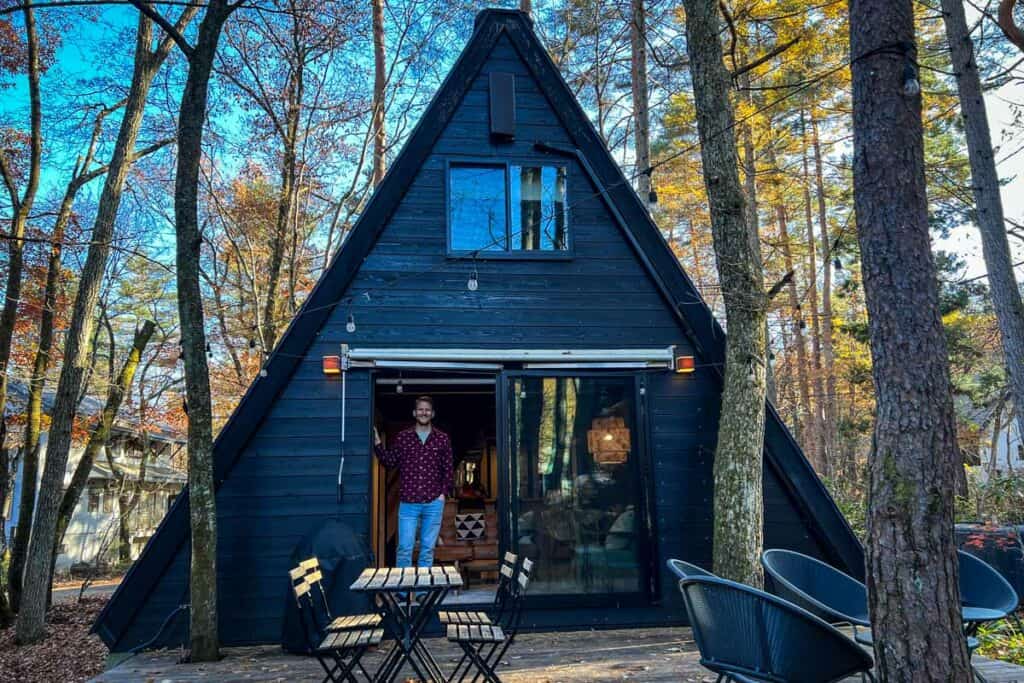
We personally love Airbnbs because you can find some really unique stays and accommodations with more than one room (especially in the countryside). There are a few caveats here:
- I’d only recommend Airbnb in Japan outside of major cities. Hotels are better in the city and have staff who can help.
- Look for places with excellent reviews. I personally aim for ratings of 4.95 and above.
- Read the reviews and filter for those that mention “kids”, “child”, or “baby” to get information specific to family travel.
- Message back and forth with the host to make sure their communication is punctual and good as this will be important. We had a host help make restaurant reservations for us and it was so helpful. (In the Airbnb app, you can also see what the host’s average response time is.)
- Here are two Airbnb properties we personally stayed at and had great experiences with:
- A-frame cabin in Hakuba (there are so many stunning cabin properties around Japan!)
- Historic inn located in the countryside near Takayama (read the description to see if this would work for your family – we had a fantastic experience and the host was wonderful with our daughter, but it’s not necessarily aimed at children)
Read more: Here are more tips for choosing accommodation when you’re traveling as a family.
17. Seek out parks and playgrounds
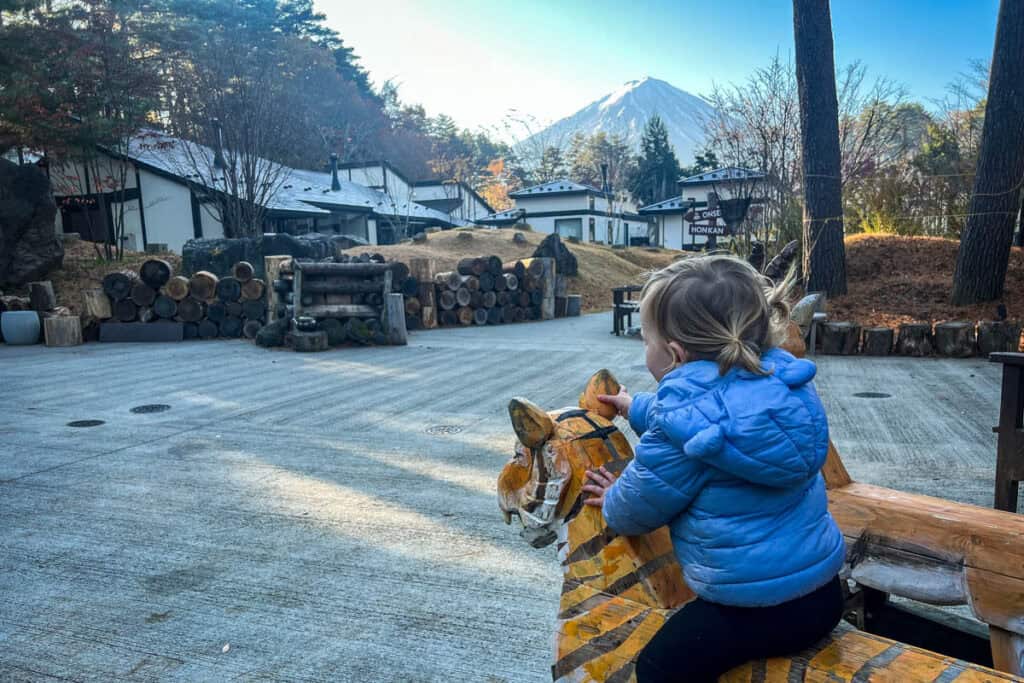
If you’re traveling Japan with a toddler, parks and playgrounds are a great place to get the wiggles out. Just like many other places around the world, playgrounds are quite common in Japan.
Playgrounds in Japan range from basic to pretty wonderful, and they are common enough that unless your child is a playground connoisseur, I personally don’t think you need to go out of your way to go to specific ones.
Simply type “playground” into Google Maps to find the nearest one to your location.
You can also prepare ahead of time and find the nearest ones to your hotels and pin them on your map so you have the location all set and you know exactly where to go.
18. You’ll make friends
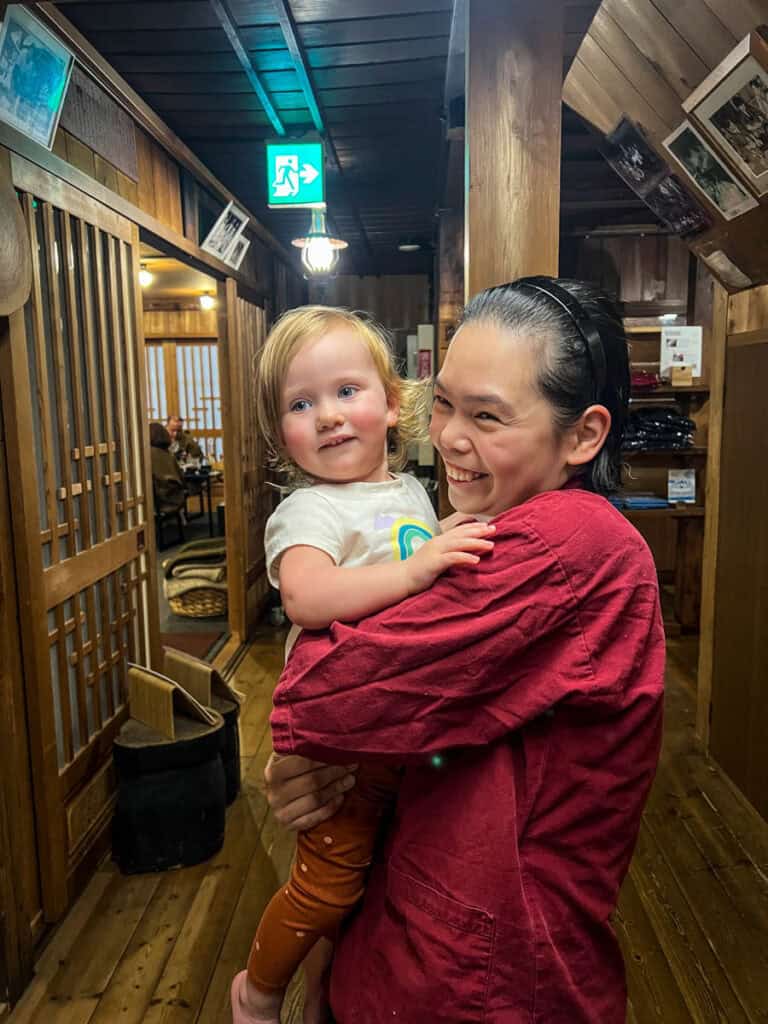
We found most Japanese people to be very friendly and kind to our daughter.
We interacted with more locals than if we hadn’t had her with us. Many people were interested in her and Japanese families often wanted to help us by pointing out the elevators and such.
19. Make things extra convenient for yourself with these perfect travel shoes
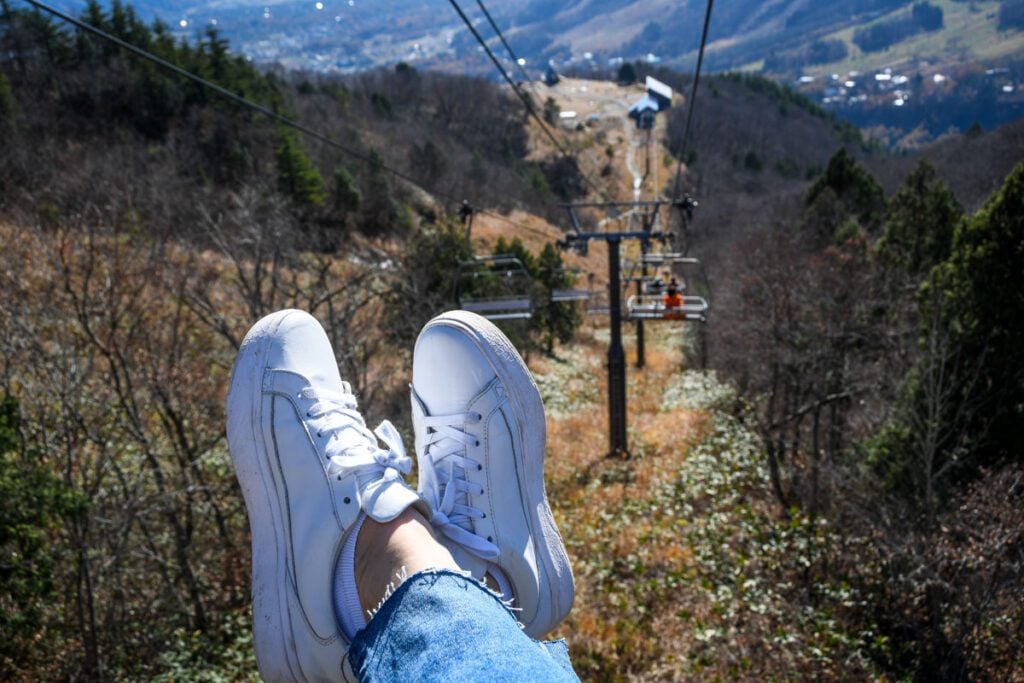
When traveling with a kid (or multiple!), it’s important to make things as easy on yourself as possible.
One thing that I was so happy I bought before our trip was a pair of Kizik shoes.
They slip on and off seamlessly, so there was no need to bend over and tie them, which was so helpful in a country where you’ll be taking your shoes off and on a lot.
Not sure what I mean? Read up on Japanese etiquette so you know all about why removing your shoes is necessary in many places.
Ben and I both got Kiziks before our trip and whether we were carrying our daughter or dealing with a tantrum, we could slip off our shoes effortlessly. I highly recommend getting a pair before your trip!
P.S. This is the pair I have and I loved that they could easily pair with casual outfits as well as skirts. And they are super comfy!
20. Carry trash bags
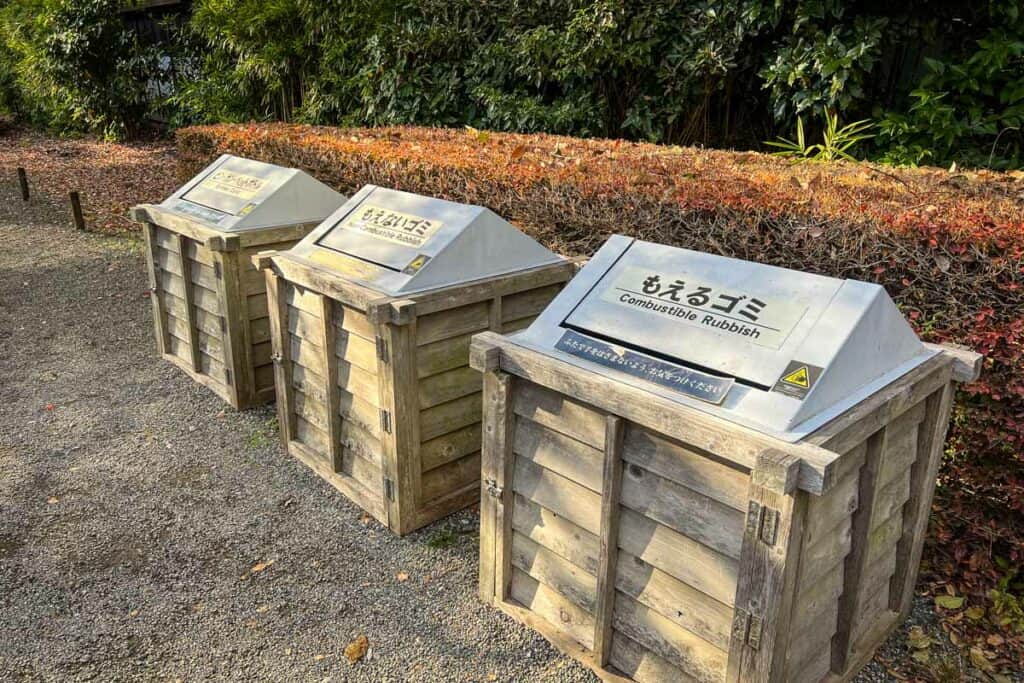
One thing many first-time visitors to Japan are surprised by is the lack of trash cans. Japan is known for being incredibly clean, yet rubbish bins are few and far between. Sometimes public bathrooms don’t even have a place for trash.
So why do you not see litter? In general, Japanese people believe in doing things that better their community as a whole (nice, right?!), including carrying their own trash until they get home or find a place to dispose of it.
You, as a visitor, should plan to do the same.
Since traveling with kiddos often means you have even more rubbish than traveling on your own – shocking, I know! – we recommend carrying a couple of bags in your daypack meant for sticky wrappers, diapers, and wipes.
You can use any plastic bag (you’ll get them whenever you purchase something in Japan) or you can pack some of the small size compostable trash bags from home.
Tip: One place you will often see trash cans is outside convenience stores. It is expected that you don’t walk and eat at the same time, so if you are going to be consuming the treat you just picked up from 7-Eleven, eat it just outside the store and throw the wrapper in the bin.
21. Look into hiring a babysitter
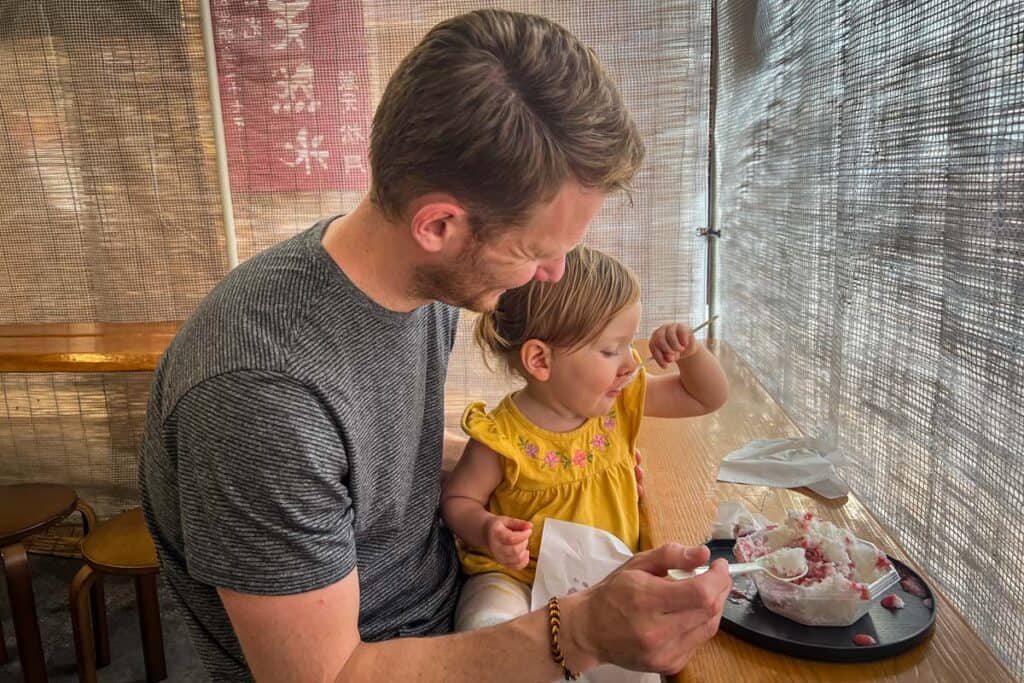
While this will certainly not be for everyone, there is the option to hire a babysitter while in Japan.
This could be so you and your partner can have a special dinner out or so you can participate in an activity where children aren’t allowed, like driving Mario Karts around the streets of Tokyo or attending a morning practice in a sumo stable.
The companies below are both well-respected and have thoroughly-vetted sitters that speak fluent English:
- Rainbow Kids Care: specifically marketed towards English-speaking families traveling to Japan
- Care Finder: available in more regions throughout Japan
The next time we travel to Japan, we will likely hire this service at least once because there are a few activities on our bucket list and restaurants we’ve been eyeing that aren’t suitable for children.
22. Consider driving
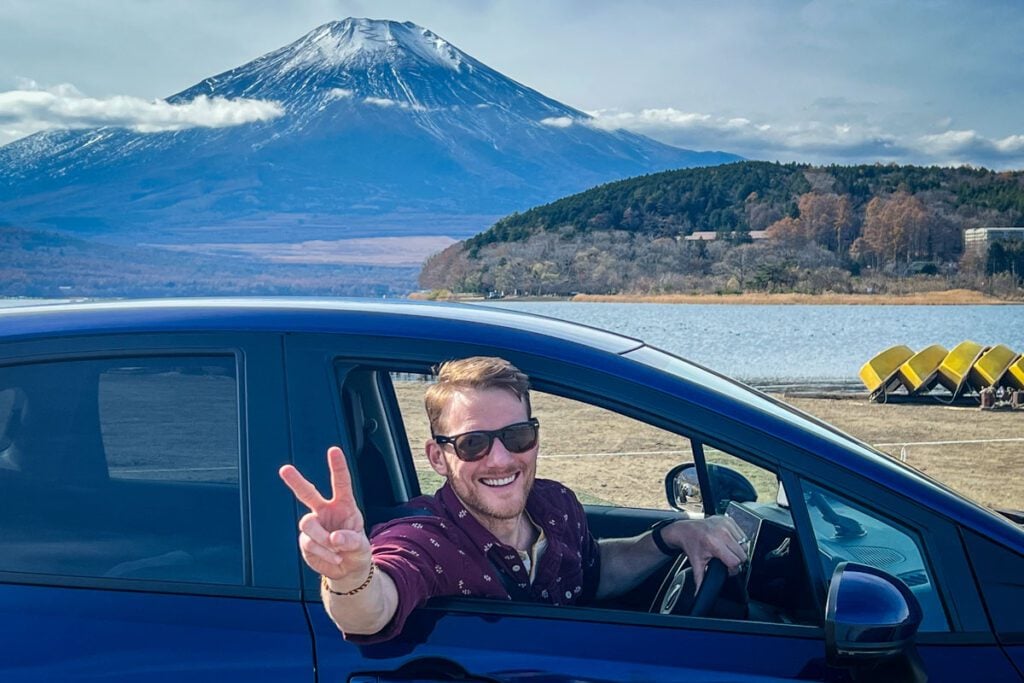
The Japanese train system is incredible. The country is very well-connected; plus, trains are clean and efficient.
If you’re only going to major cities (think Tokyo, Kyoto, Osaka, etc.), taking the train is the best choice.
Alternatively, if you’re nervous and just don’t feel comfortable with the idea of driving in Japan, no worries – you will still have a fantastic trip taking only trains.
In the next section, we’ll go over things to know about traveling by train in Japan with kids.
However, don’t write off the idea of renting a car in Japan. We did this on our most recent trip to Japan, and it was the best idea ever.
I honestly don’t think we’ll ever travel in Japan again without a rental car (at least for part of the time).
Why renting a car might be a good idea for a family trip
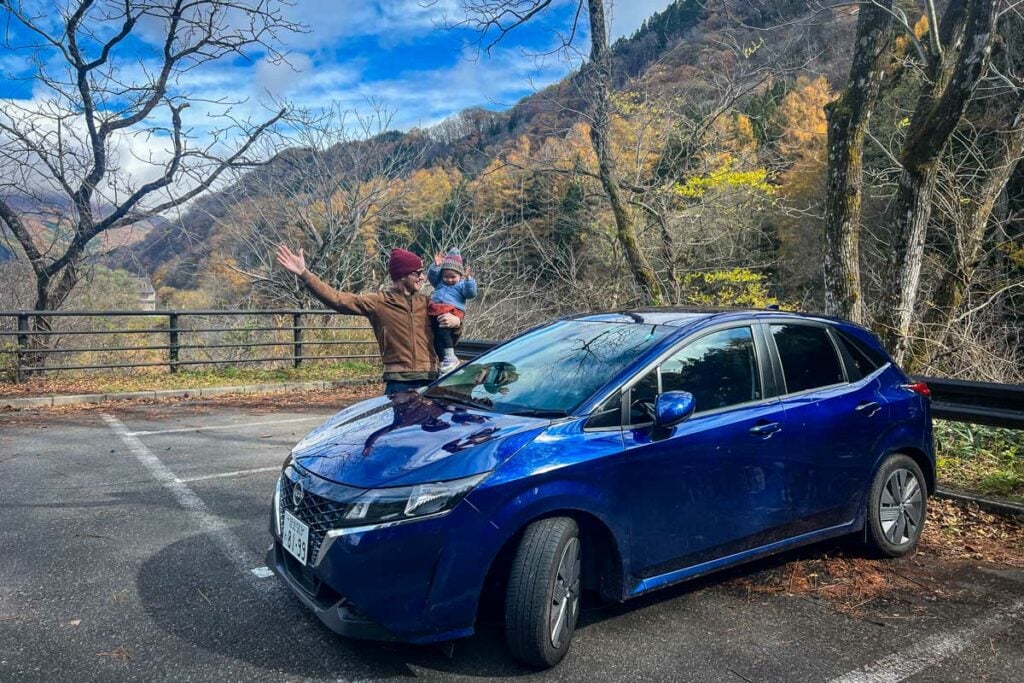
- You can get off the beaten path easier. We love Japan’s big cities as much as the next person, but our favorite places in the country are, without a doubt, the small towns and villages. We think these places are even more special to experience with little ones. The pace of life is slower, your interactions will be more meaningful, and the landscapes are more beautiful. It can be difficult to access these places using only public transportation, and renting a car will be quicker and more efficient.
- You can go at your own pace. We love having our own car when traveling with our daughter. We don’t have to worry about getting to the train station at a certain time, we can pull over and take a break to get the wiggles out, and we have a private space for dealing with diaper changes.
- It can be easier (in some ways). You won’t have to lug your bags around the train station with a little one in tow or worry about disturbing others around you on the train. Depending on your personality and comfort level, driving yourself can give you a bit more peace of mind.
Seriously considering renting a car in Japan? We’ve got an entire guide with everything you need to know about choosing your car and tips for driving in Japan.
Trains in Japan with kids
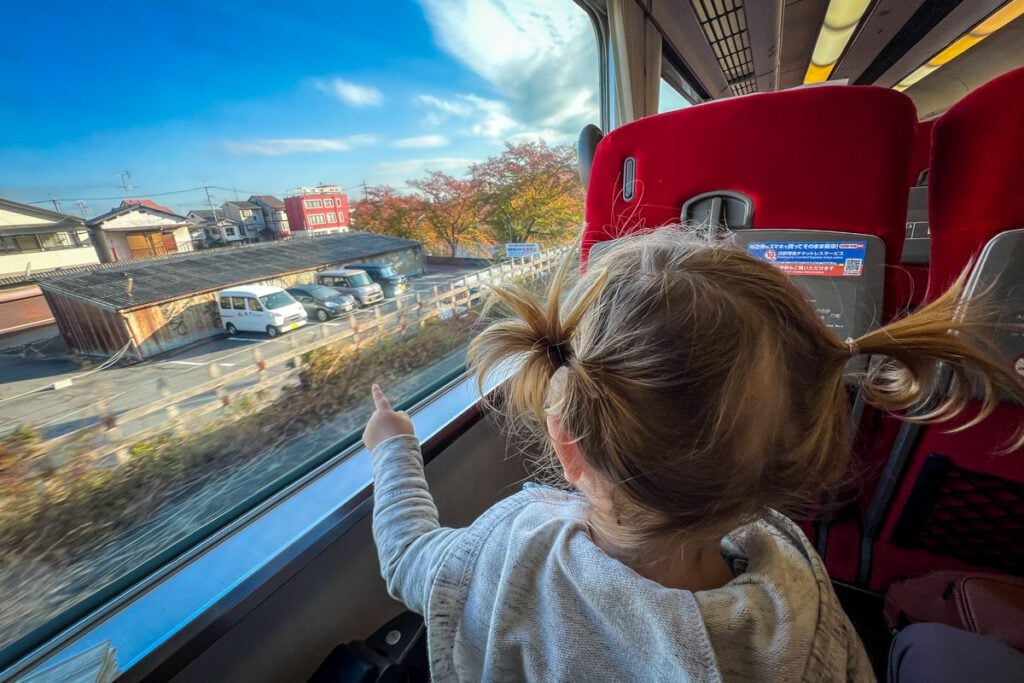
When we traveled to Japan with a toddler, we did a mix of train travel and renting a car. Both worked really well.
If you’re mainly going between big cities, the trains will be great. You will certainly see other kiddos (both Japanese and travelers) on the trains.
Here are some tips and things to know before you hop aboard!
Public transportation is very quiet
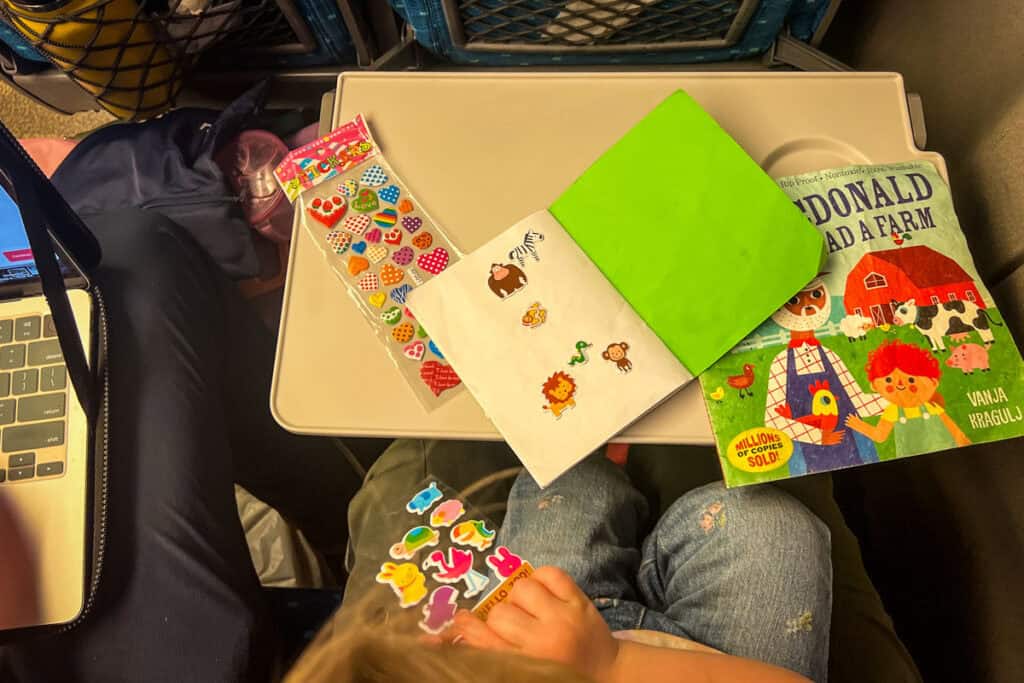
In Japan, the subways and trains are very, very quiet. This can be a bit intimidating if you are traveling with a chatty toddler, but I can assure you that it will be okay.
Prepare your child beforehand by telling them you’re going on a very quiet train. Practice whispering, and bring quiet activities along to keep them entertained.
And if they have a little outburst, don’t fret. There will likely be Japanese parents nearby who have gone through the same thing. Calmly and patiently try to soothe and redirect.
There are special sections in the subway cars for strollers
When you’re using city transportation (like subways), there’s a special section of the cars where you can park your stroller. Look for the icons to help guide you.
Remove your child’s shoes if they have their feet on the seat
One major piece of Japanese etiquette you should know is that you should never put your feet up on a piece of furniture, as it is considered rude.
If your little one is on the seat and their legs aren’t long enough that their feet hang down, take off their shoes and store them in your bag until you are ready to depart. (Keep socks on.)
Know if you can eat or not
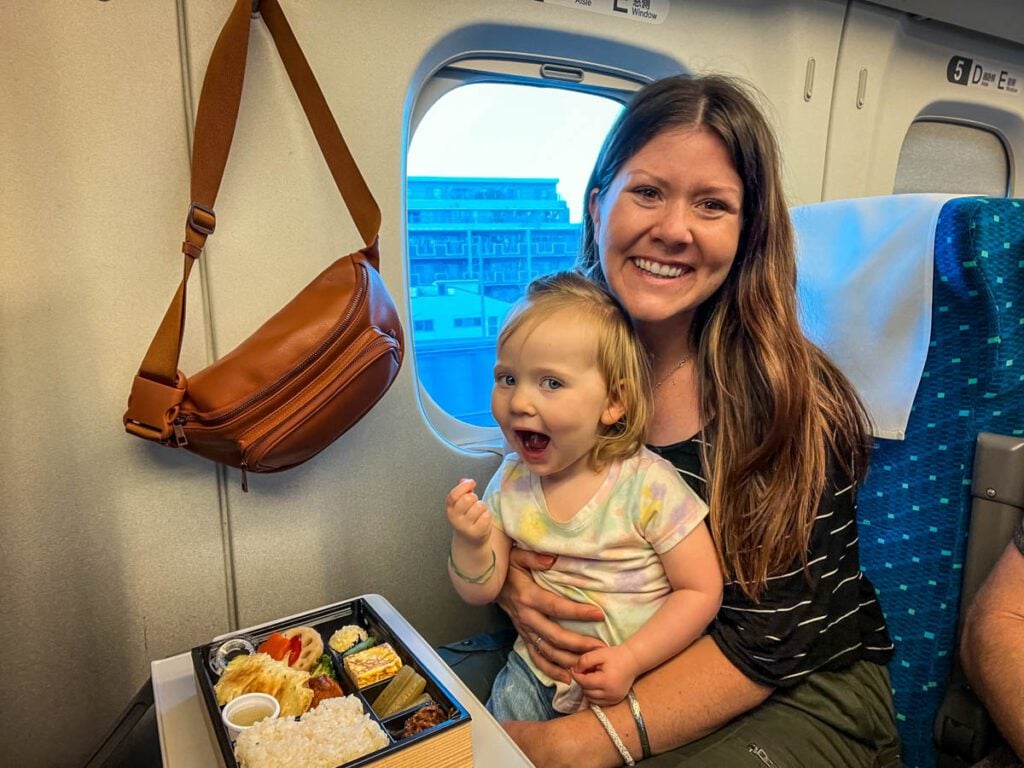
You are allowed to eat on some trains, but before you open that bento box, look around and see if other riders have food out.
A general rule of thumb is that you can eat on long distance trains, like Shinkansen, but you should refrain from eating on regional trains and city subway cars.
Tip: If you’re about to ride a train where you won’t be able to eat, be sure your kiddo has already eaten or has a quick snack before hopping on board.
Japanese foods for picky eaters
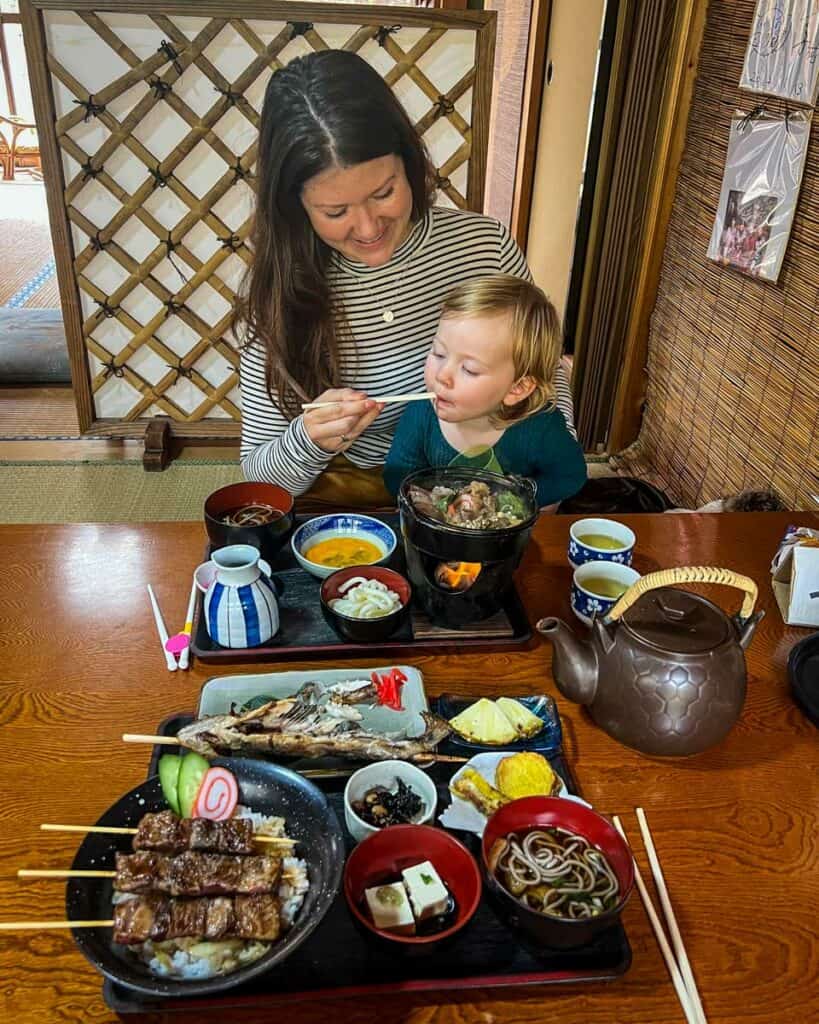
Our daughter might be an outlier, but she really likes all foods (so far!). Overall, she did really well with the foods in Japan.
Even if your child is picky when it comes to food, there are quite a few “safe items” in Japan.
These are the dishes we’d recommend trying with your little one:
- Onigiri: rice ball shaped into a triangle with different fillings (easy to grab from convenience stores)
- Edamame: order as an appetizer or grab a bag from convenience stores
- Tonkatsu: breaded pork cutlets
- Ramen: there are many types to choose from
- Miso soup: mild flavor with tofu
- Gyoza: dumplings, similar to potstickers
- Tempura: battered and fried vegetables and shrimp
- Cucumber roll: available in some places that serve sushi
- Yakisoba: fried noodles and veggies
- Karaage: Japanese fried chicken
Good to know: One more thing to point out is that in big cities you will have no problem finding Western or other international cuisines. Unless there are dietary concerns, we personally recommend starting by having your child try some of the foods mentioned above so that you can experience the amazing foods Japan is known for.
Things to pack for traveling in Japan with children
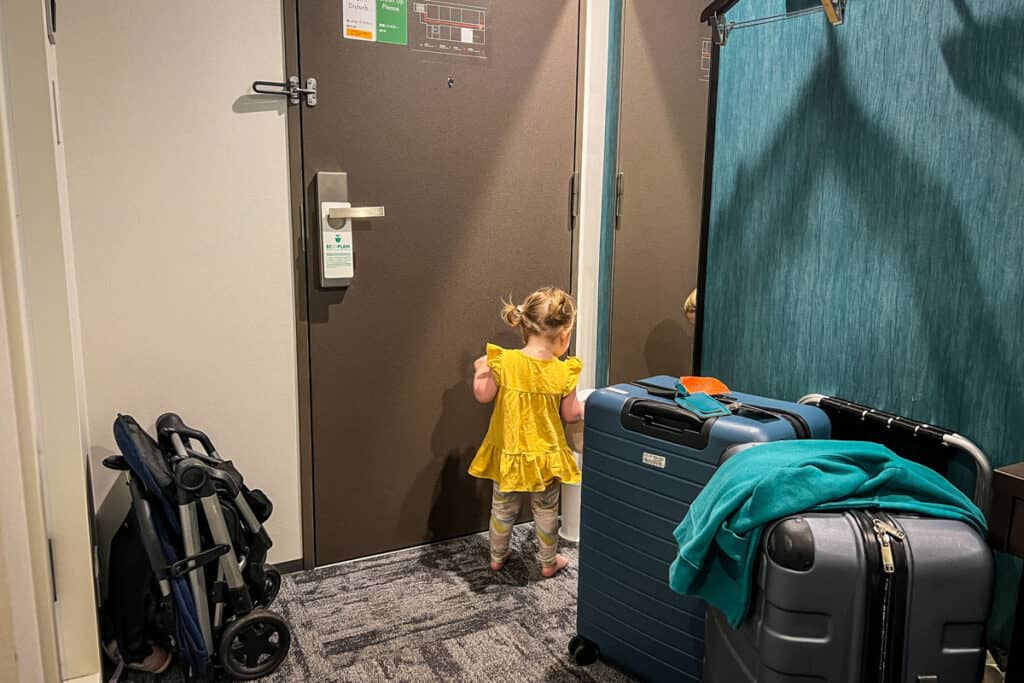
- Compact travel stroller
- Baby carrier
- Diaper bag fanny pack
- Jet lag pills
- Nursing cover
- Potty seat (if your child is potty trained)
- Small trash bags
- Aeropress
- eSIM: this is the one we used in Japan and it worked seamlessly!
- Read more: curious about the pros and cons of a SIM vs. a WiFi hotspot device? We’ve used both in Japan and have some strong opinions!
- Window screen: if you’re planning on renting a car this window sock will keep the sunlight out of their eyes.
- Note: We like this type because it packs up really small and doesn’t leave gaps where sun gets in. That said, it darkens the window and takes a bit of getting used to. We recommend driving with it at home for a few days first to see if it’ll work for you.
- Tablet
- Puffy stickers and small notebooks
Kid friendly activities in Japan
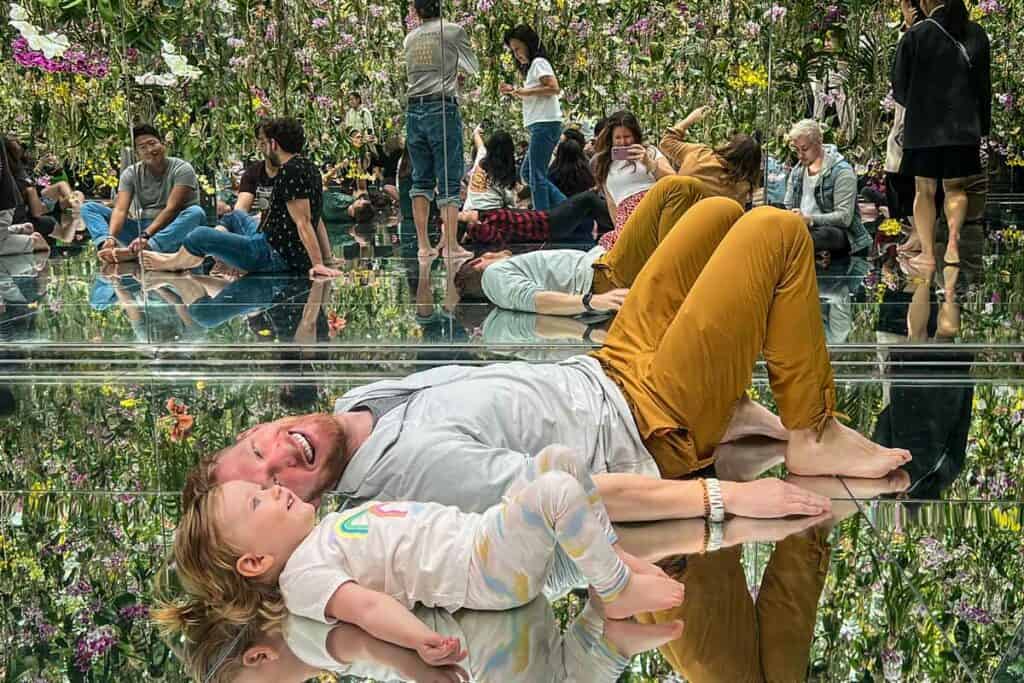
Japan truly is such a perfect place for kids to be kids. There are many activities that allow adults to tap into their inner child, and celebrate playfulness and imagination.
Here are just a few of the activities that we think are worth putting on your itinerary if you’re traveling with children:
teamLab exhibits
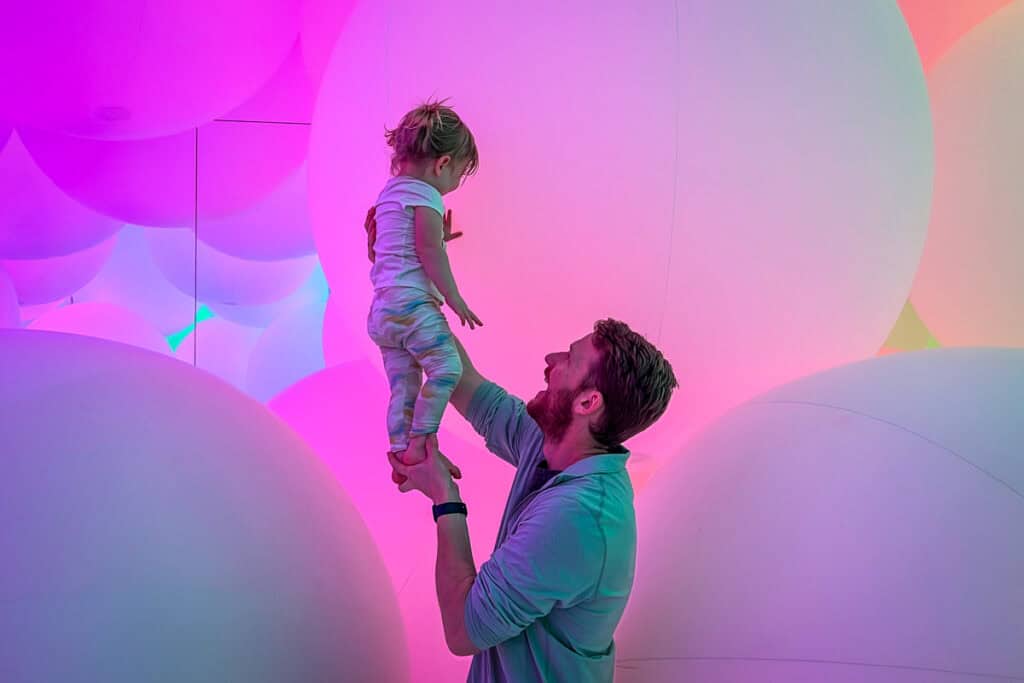
The Tokyo-based art collective known as teamLab is famous for creating art installations that are unmatched.
They have several immersive digital art exhibits throughout the country, and they are perfect for people of all ages.
While there are several to choose from, the two most famous exhibits are teamLab Borderless and teamLab Planets, both located in Tokyo.
Which is better? Honestly, they’re both great, but if we had to choose just one we’d pick Borderless!
We brought our daughter and I don’t know which one of us enjoyed it the most! It was just so much fun and we got all sorts of family photos.
If you are traveling to Japan with kids, we highly recommend putting this on your itinerary!
Helpful to know:
- Spots to visit these exhibits sell out, so be sure you reserve your tickets well in advance!
- Book Borderless
- Book Planets
- Plan to spend 3-4 hours here.
- Read more about the museum and what to expect in our teamLab Borderless guide.
Shrines and temples
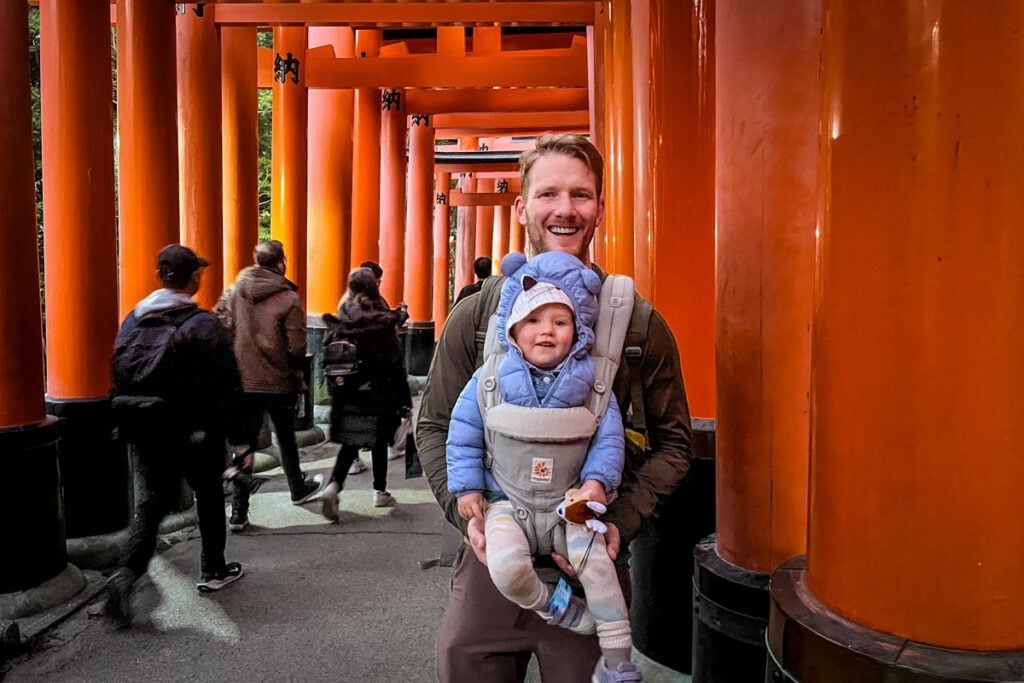
Shrines and temples are excellent places to bring children while traveling in Japan and will expose them to a new culture.
Depending on your child’s age, you may want to prepare them by going over some etiquette. But don’t stress too much. Shrines and temples are frequented by Japanese families.
It’s not often that the grounds are completely quiet (especially at the more popular ones).
If your child is having a hard time, just don’t go inside the actual buildings. These are often reserved for worshippers and tend to be quiet. Temple and shrine grounds are often large and you should be able to find a spot to get some space and redirect them.
Disney, Universal Studios, Harry Potter, Ghibli
This might be an obvious one, especially for older children.
Japan has quite a few theme parks. If your kids are into it, be sure to devote some time in your itinerary for these experiences.
There are some things you should know about theme parks in Japan:
- They are typically very crowded. For the parks where an express pass is available, it is a worthwhile purchase.
- You must book tickets in advance. Some sell out early on, so look into the one(s) you’re interested in and set an alarm to snag your tickets.
Deer in Nara
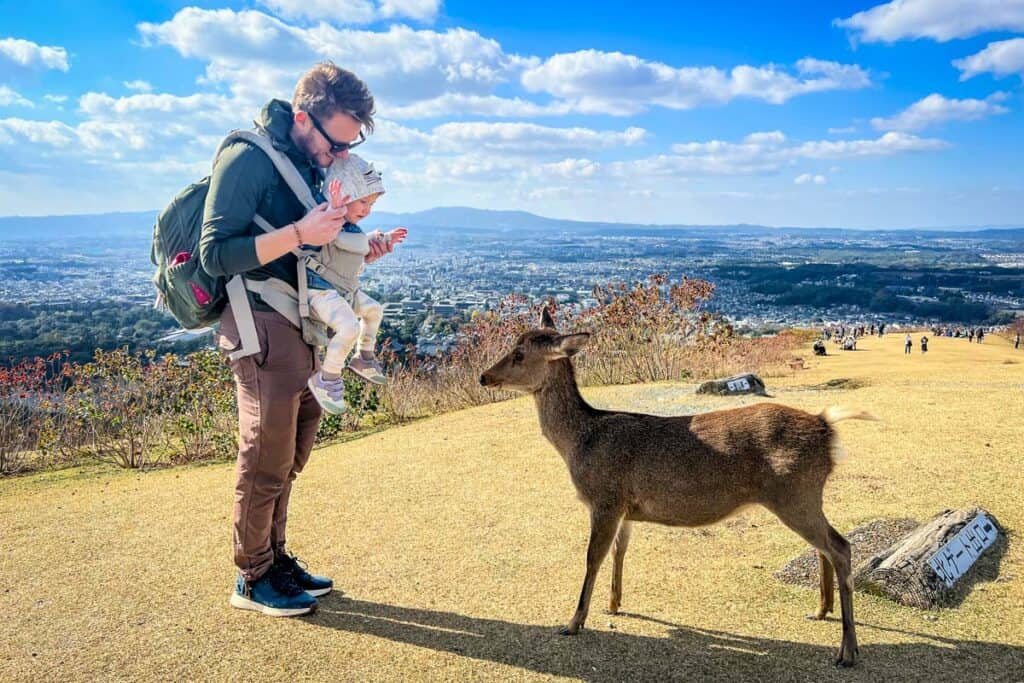
One of the coolest (and easiest) experiences you can have with children in Japan is seeing the famous Nara deer.
They roam freely around this ancient city and you can feed them specially-formulated deer crackers to get an up-close experience.
Nara is easily reached from Kyoto and Osaka, and makes a great day trip from either base.
We have a perfect Nara day trip itinerary planned for you. Bonus: We actually followed this same route with our toddler, so it has been child-tested and approved!.
Snow monkeys
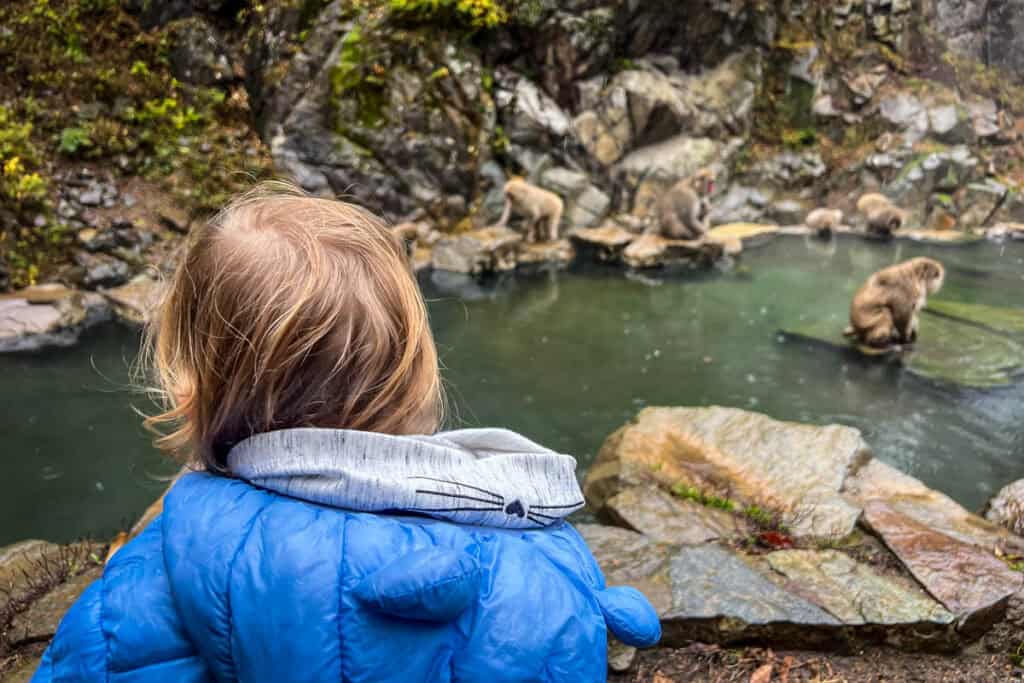
Another pretty incredible animal encounter you can have is seeing monkeys at the Jigokudani snow monkey park.
Located in Nagano prefecture, this is not as easy to access as Nara, but it can be super worthwhile.
Seeing the Japanese macaques soaking in a hot spring is pretty magical, especially if you’re visiting during the snowy winter months or during Japan’s fall foliage when the area is particularly beautiful.
We have a complete guide to Jigokudani Monkey Park that’s packed with important info and insider tips to plan the perfect visit.
Theme restaurants and cafes
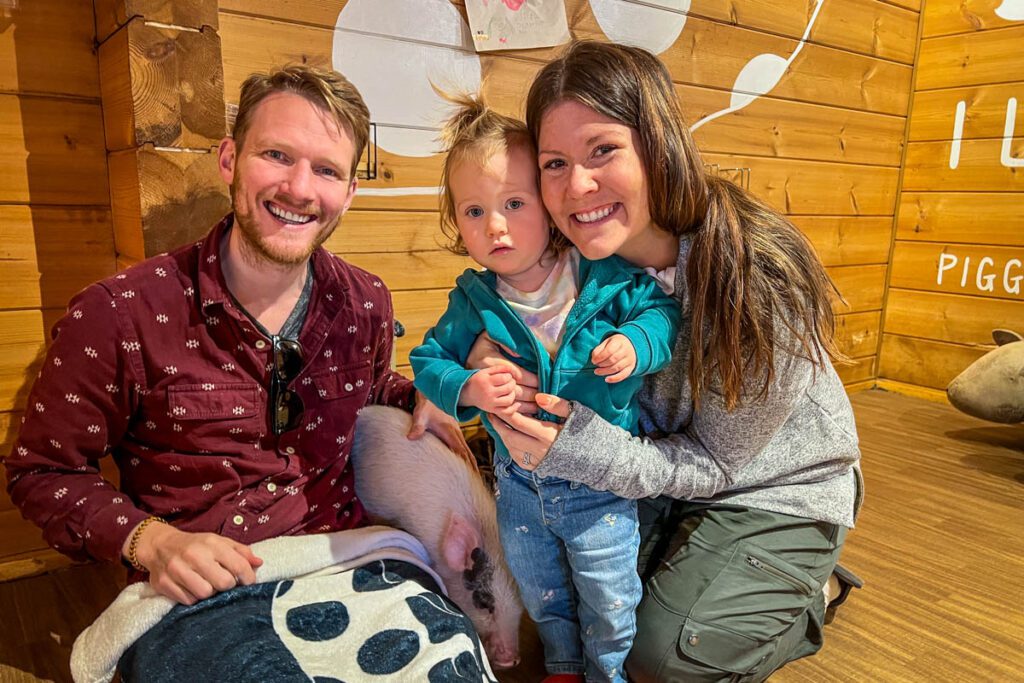
Japan is known for themed restaurants and cafes that can be enjoyed by guests of all ages. Some are better suited to adults, while others are perfect for the kid in all of us.
Popular ones include Tokyo’s Pokemon Cafe and the Ninja restaurant, but the options are endless.
We recommend doing research well in advance of your trip as some of these themed restaurants book up months ahead.
Word of warning about animal cafes:
Japan doesn’t have the best track record with animal welfare. Therefore, we’d recommend avoiding most animal cafes (which are common in Japan).
Some animals featured at these cafes are nocturnal, like owls. Others don’t like being social with people they don’t know, like hedgehogs. Also, there often isn’t enough space (especially in Tokyo’s cafes) for the animals to live comfortably.
There are a few exceptions to this, like some cat cafes (this is a rescue cat cafe!). Also, we visited this miniature pig cafe on the outskirts of Tokyo. The pigs had both indoor and outdoor spaces to live and play, and they seemed very well cared for.
Dinner in a local’s home (Nagomi visit)
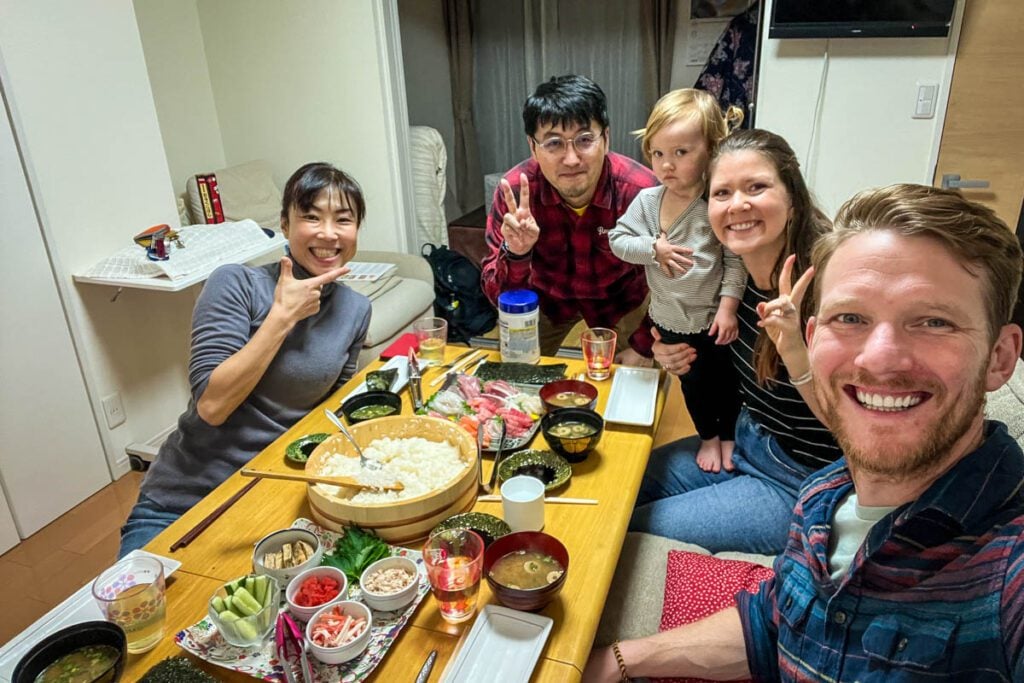
Dining with a local family in their home will surely be a highlight of your family trip to Japan.
Nagomi Visit is a really cool program that essentially pairs you with a local family with whom you can enjoy a homemade meal. In addition to great food, it’s also a unique opportunity to get a glimpse into authentic Japanese culture and daily life.
We met the sweetest couple who walked us through their neighborhood (an area of Tokyo we never would have discovered on our own, but loved—we’ll likely stay here during our next trip!).
They gave us a tour of their home and had us help with making dinner.
Together, we enjoyed a delicious meal of temaki (hand roll sushi) and had great conversations. It was such a special experience, especially with a toddler! We can’t wait to do it again the next time we’re in Japan.
How to sign up:
- Create a profile on the Nagomi Visit website, including a photo and description of who will be visiting.
- Create requests for each train station you would be available to meet at, as well as the dates you are free. You can choose either lunch or dinner.
- Families in those neighborhoods will see your request and can then respond to your request with an invitation.
- Read through your invitations and each family’s profile to find one that you think is a match.
- When you accept an invitation, you will receive meal options to choose from, as well as instructions about where to meet. You can determine a time that works for both parties.
- Make sure you communicate well with your host and arrive at the meeting place on time.
Good to know: You can also experience this in other large cities around Japan, like Kyoto and Osaka, as well as some rural areas.
Family photo shoot
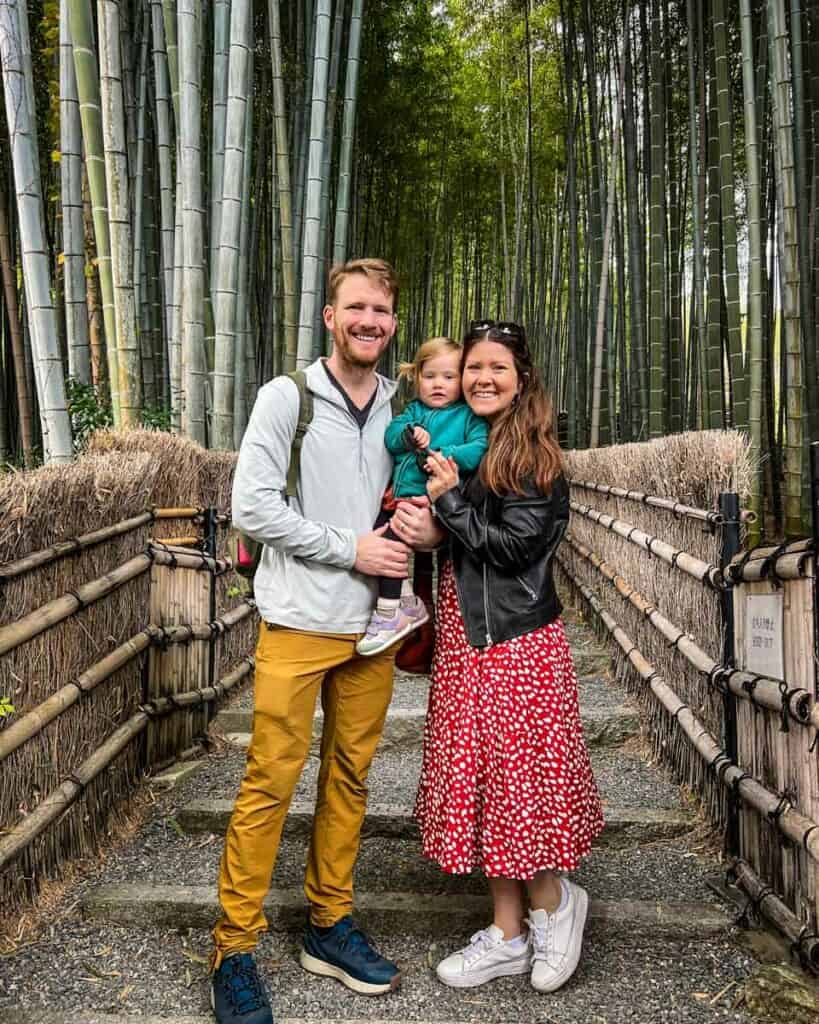
Many families schedule photoshoots at home to have special keepsakes, but why not opt for doing your family photos on your Japan vacation?!
There are few better souvenirs than photos of special memories on your trip. And it’s arguably more sweet when the photos are of your whole family.
We recommend searching Airbnb Experiences for “photography” in the cities you’ll be traveling in. Want a rec? This photographer in Tokyo does excellent work!
Alternative (or additional!) family photo experience:
If you’re on a tight budget (or even if you’re not!), hop into a Japanese photo booth, or purikura, for a quick but memorable experience, as well as a very cheap souvenir!
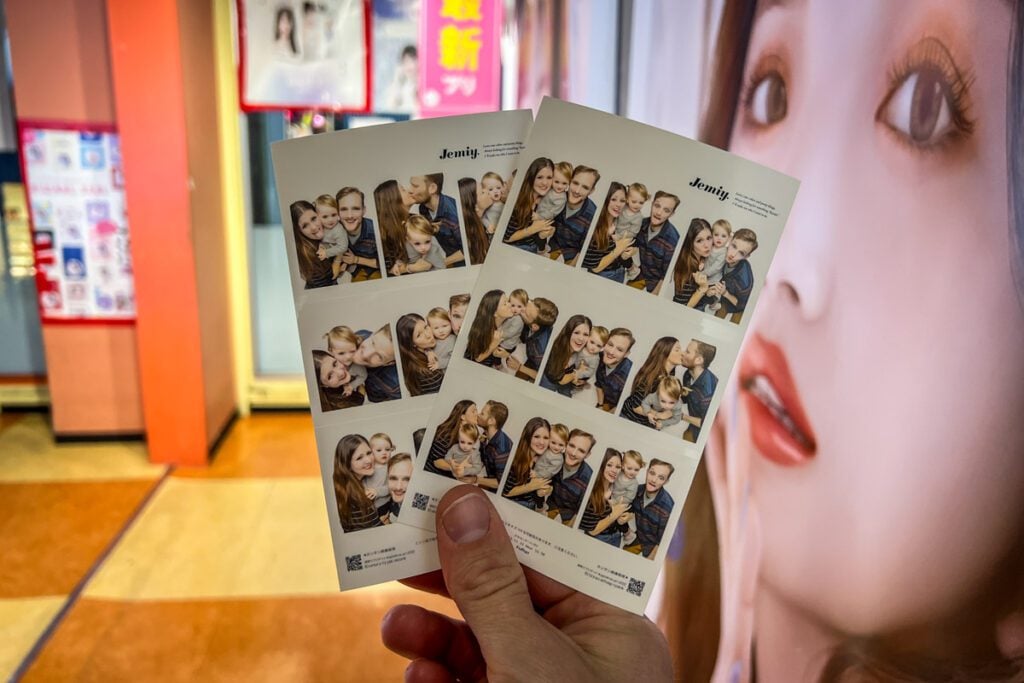
You can find photo booths in many arcades, and sometimes simply typing “purikura” into Google Maps will show you any nearby.
The best part is this experience takes less than 10 minutes and costs around 400 yen, meaning any family can squeeze it into their Japan itinerary, no matter how tight!
Activities that are not child friendly
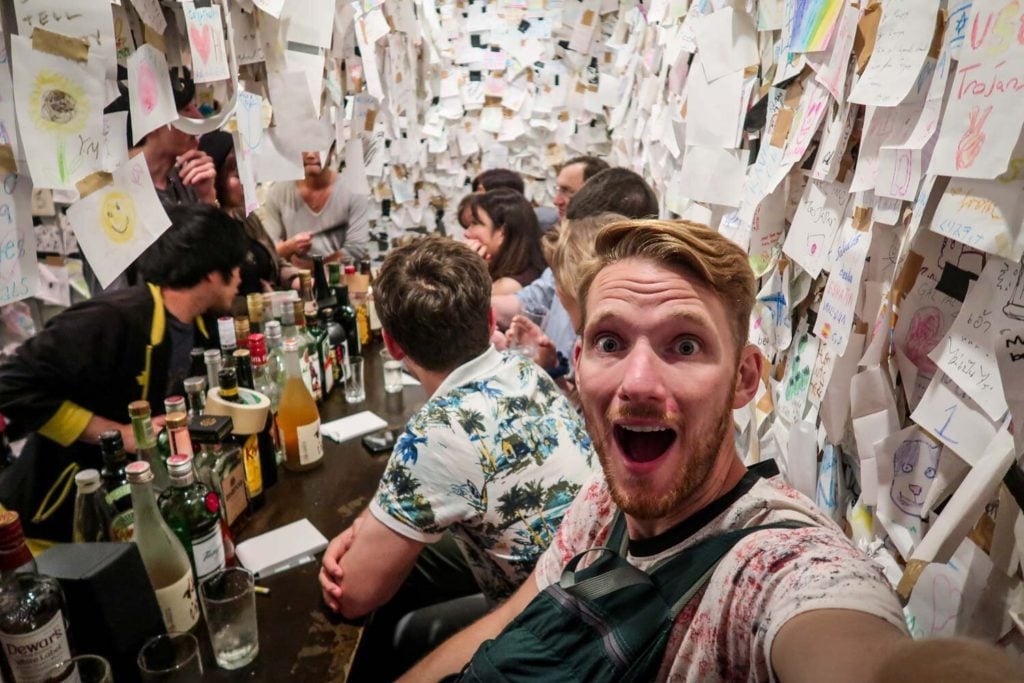
Here are some Japanese experiences that you should save for a child-free trip.
Izakayas
While there are some exceptions to this, in general, izakayas tend to be intimate bars for people who are 18+.
If you’re traveling with kids, you can still experience some incredible, cozy little restaurants that have izakaya-like vibes. But the true nightlife should be left to adults.
Sumo stables
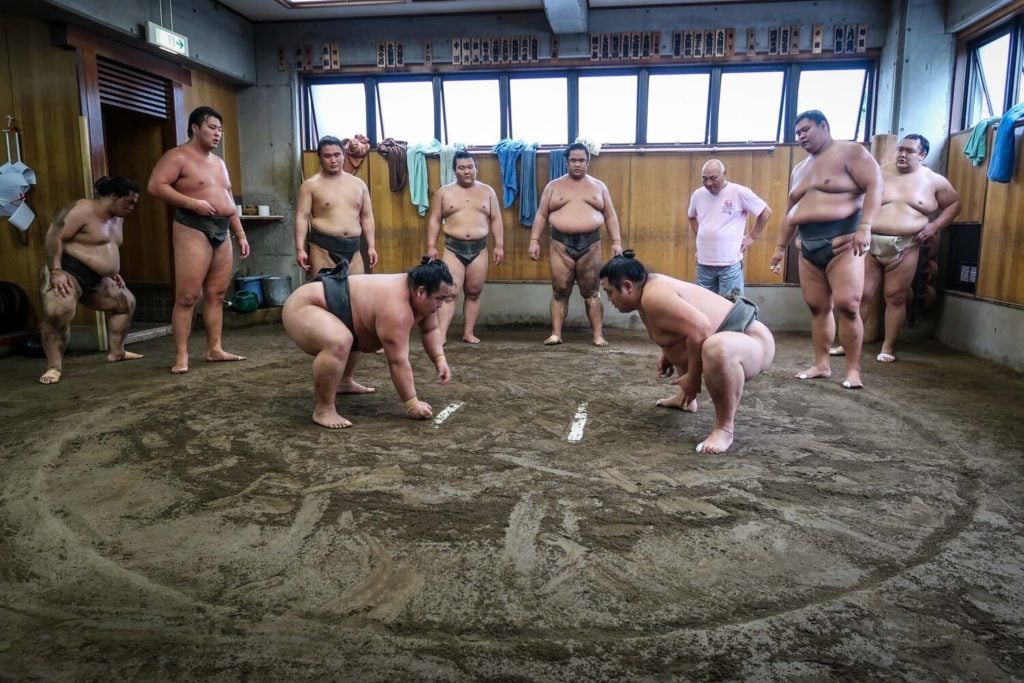
Getting to see sumo wrestlers in their morning practice is a bucket list experience in Japan. However, children under 12 years old are not allowed, and for good reason.
Participants must sit quietly (like, no sounds or bathroom breaks!) for more than an hour.
Tea experiences
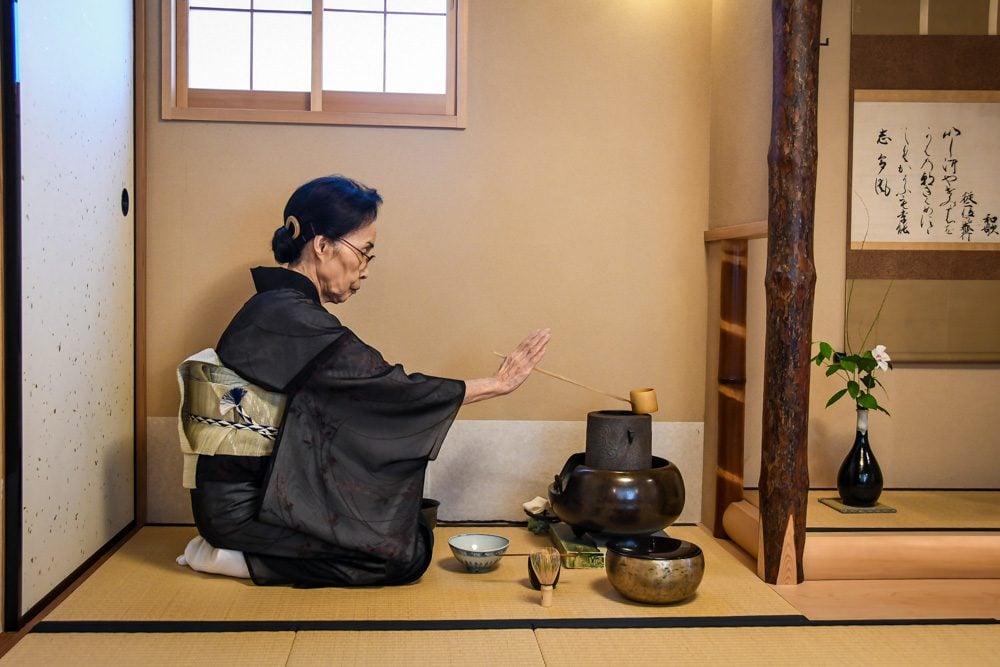
Many tea ceremonies do not allow children because of the length and nature of the experience.
There are some tea houses that do a short version of a tea ceremony or private experiences where children can join if this is a top priority of yours.
Capsule hotels
Staying in a capsule hotel is one of those very “Japanese things” and it is cool to experience yourself. That said, it’s not a good choice if you’re on a family trip to Japan. Each capsule is very tight and is intended for one person, mostly just to lie down.
Onsen with kids
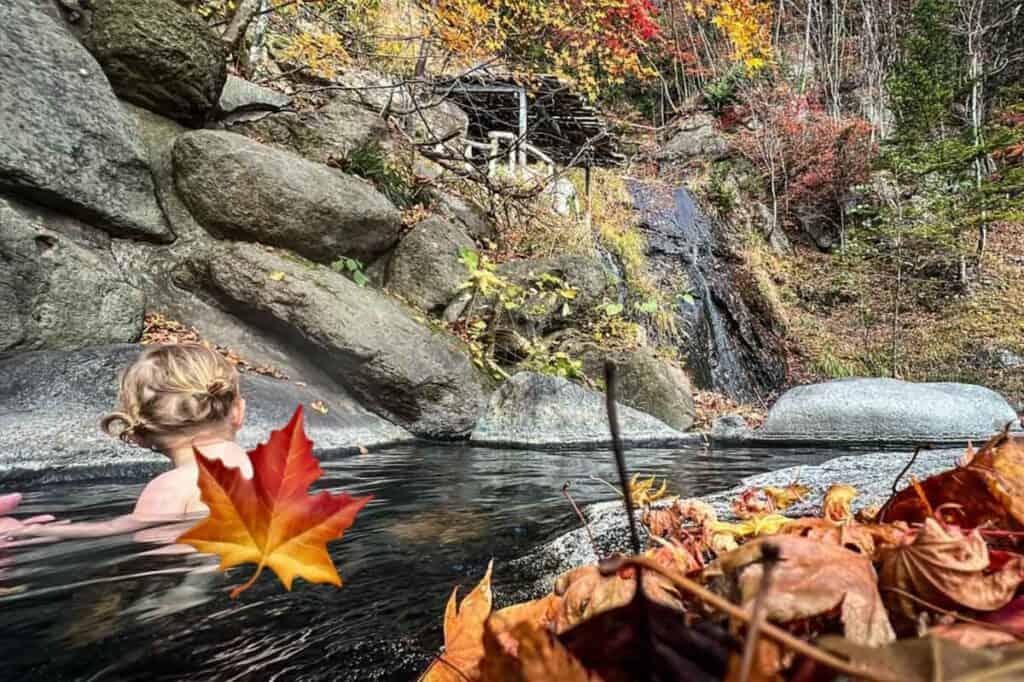
I can’t quite decide whether to put onsen in child-friendly or not child-friendly, so it gets its own section entirely.
Before traveling to Japan with a toddler, I had a lot of questions about going to an onsen with kids and there wasn’t a ton of information about this online.
Soaking in onsen is one of my very favorite things in Japan, and I was hoping we could make it happen.
Spoiler alert: We did end up getting to soak in 2 of the 3 onsen we’d planned to.*
- One was a mixed gender onsen at an onsen resort we stayed at in Nikko National Park and it was ahhhh-mazing (pictured above).
- The second was a private onsen we booked at our glamping accommodation near Mount Fuji. Again, wonderful. Our daughter was actually napping during our soaking time. We set her up in the stroller right next to us as we soaked.
- The third was an outdoor onsen near Kamikochi that actually allows swimsuits. We were super excited for this one, but when we arrived we were disappointed to find it is only open seasonally (during the summer), so there was no water in it. Womp womp.
*This doesn’t include the accommodations where we had access to private onsen rooms.
Depending on the specific onsen itself, as well as your child and their age/upbringing, it can be a great family activity or a not-so-great one.
I think going to an onsen can be a great family activity. That said, you do have to put a bit more thought into it than you would without children.
Here are all of the things to consider before planning to visit an onsen with a child:
Gender separation
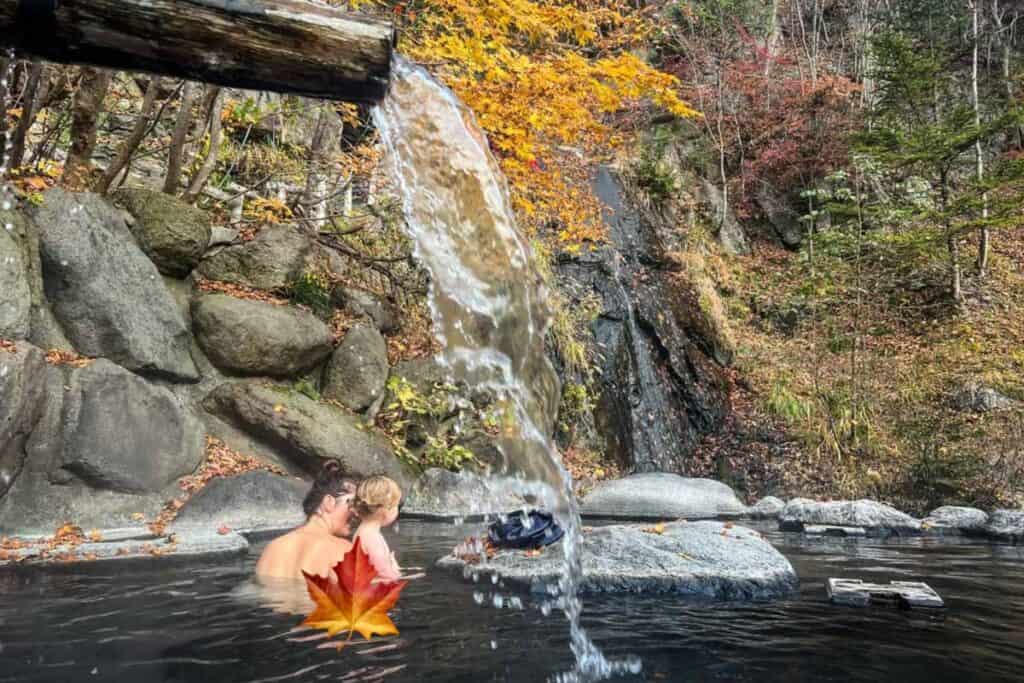
Most onsens are gender-separated, so (hetero) parents will likely have to split up and one will be with the child.
Booking a private onsen can be a great compromise here as both parents can be together with the child. This also takes away the concern of disrupting other people who are soaking, making it a more peaceful experience for most parents.
Good to know: Taking photos in a public onsen is a no-no, for obvious reasons. Any photos you see here were taken when we were the only ones using the onsen.
Swim diapers
Bathing suits are almost never allowed in onsen, including swim diapers. This can be a challenge if you have a baby who isn’t potty trained. In this case, you may want to speak with someone at the onsen directly about this.
Our experience: Our daughter was not yet potty trained before going to Japan, but she was at a stage where she was dry for a long time between wet diapers. When we spoke with the hotel staff at our onsen resort they said it was no problem for her to go in with us. We’ve heard from others that seeing babies in onsen isn’t super uncommon.
Nudity
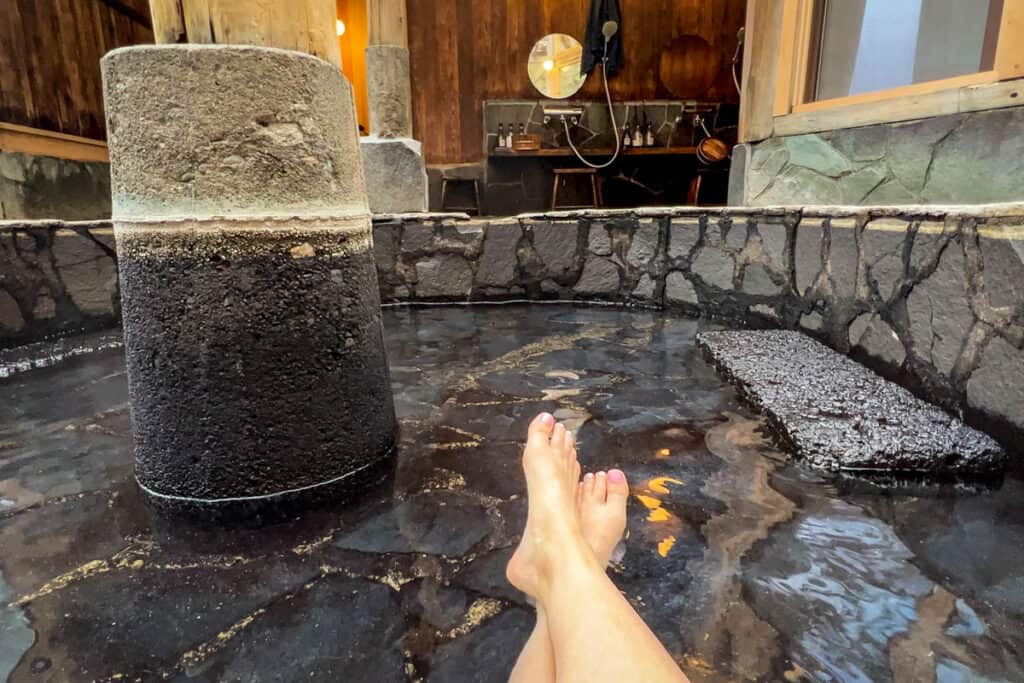
Depending on your child’s age and their upbringing, nudity can be a concern for some parents. I’m all for normalizing nudity, but it comes with a lot of layers. It may work for some families and not others.
In many Asian cultures, going to the bathhouse with your family is part of life and this is how generations have been raised. However, many Western cultures have a much different relationship with nudity and privacy.
Some older children may not feel comfortable being nude in front of their parents (or strangers), and vice versa.
If this is a concern of yours, look for water parks and pools instead. These won’t be onsens per se, but some water parks have elements of an onsen, making them a bit different from what you might be used to in your home country.
There are also a handful of true onsens in the country that do allow people to wear bathing suits.
Disturbing others
You know your child best: Will they want to splash and swim around as soon as they get into the water?
Depending on their age and personality, a public onsen may not be the best experience, both for you (having to reign them in) and for those around you.
Water temperature
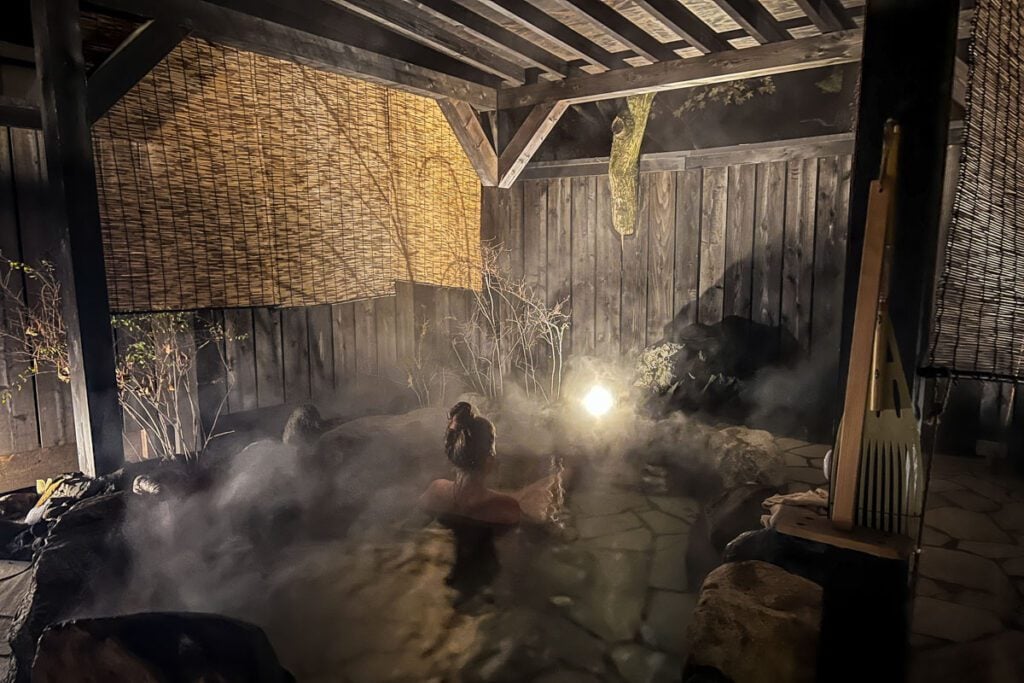
Depending on the specific onsen, the temperature may be quite hot. Large facilities that have several pools often have some at varying temperatures. This makes it possible to find an area that feels more like bath water than a super hot hot tub.
Best case scenario for experiencing an onsen with kids (in our opinion): Book a private onsen so it will be just you and your family (no need to worry about disturbing others or being separated).
Alternative: footbath
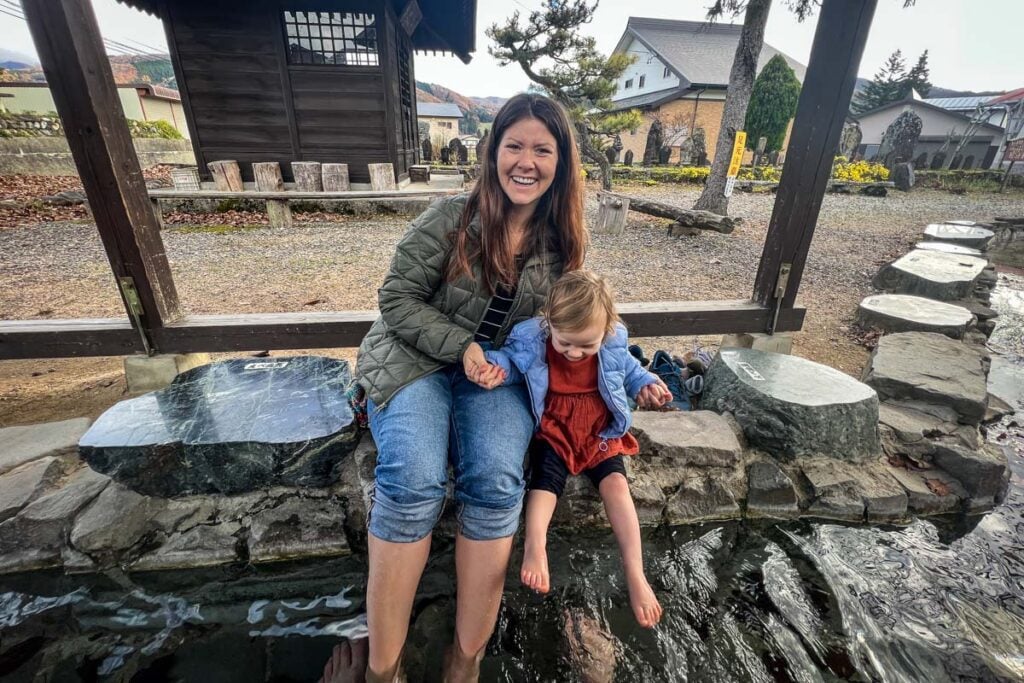
If you want to experience some element of an onsen with your family without getting the “full monty”, a footbath could be a good alternative.
You can find footbaths, like this one at the Arashiyama train station in Kyoto, all around the country. Soaking your toes in the warm water is especially soothing after a long day of exploring on foot.
Plan your trip to Japan
After 3 trips (and counting!), we’ve fallen head over heels for Japan—and we’ve created TONS of resources to help you plan your dream trip. Start with our Ultimate Japan Travel Guide and be sure to check out these helpful articles:
- First time? Our Japan Trip Planner walks you through everything you need to know.
- Use our Japan Rail Pass guide to determine if getting a train pass is optimal for your trip.
- Here’s our curated list of the best things to do in Japan—from iconic sights to once-in-a-lifetime experiences.
- Not sure where to go? Our Japan itinerary ideas will help you map it all out.
- Foodies, rejoice! This guide to what to eat in Japan will have you drooling before you land.
- This guide to what to wear in Japan (and what not to wear) will help you blend in.
- Use our ultimate Japan Packing List to make sure you don’t forget anything.
- Before you go, brush up on these essential Japan travel tips (including major do’s and don’ts!).
- Avoid awkward moments by brushing up on Japanese etiquette.
Still have questions? Drop us a comment—we LOVE helping travelers plan unforgettable trips to Japan!
Perfect Japan itinerary
Want the perfect itinerary planned for you?

If you don’t have a ton of time to spend planning your Japan itinerary (or you just don’t find travel planning fun), we’ve got something you might be interested in…
We created the ultimate done-for-you Japan itinerary that is packed full of all sorts of tips we’ve gathered from 3 trips to Japan as well as literally hundreds of hours of research (no exaggeration).
We have both an off-the-beaten path route as well as a classic itinerary that hits the top attractions (perfect for your first visit to Japan!).
Don’t miss your chance to grab our Japan packing list!
This FREE PDF download includes everything you’re going to want to pack for your Japan trip, including what NOT to bring, plus tons of insider tips!
Just enter your email and we’ll immediately send you access instructions!
Save this article on Pinterest for later!
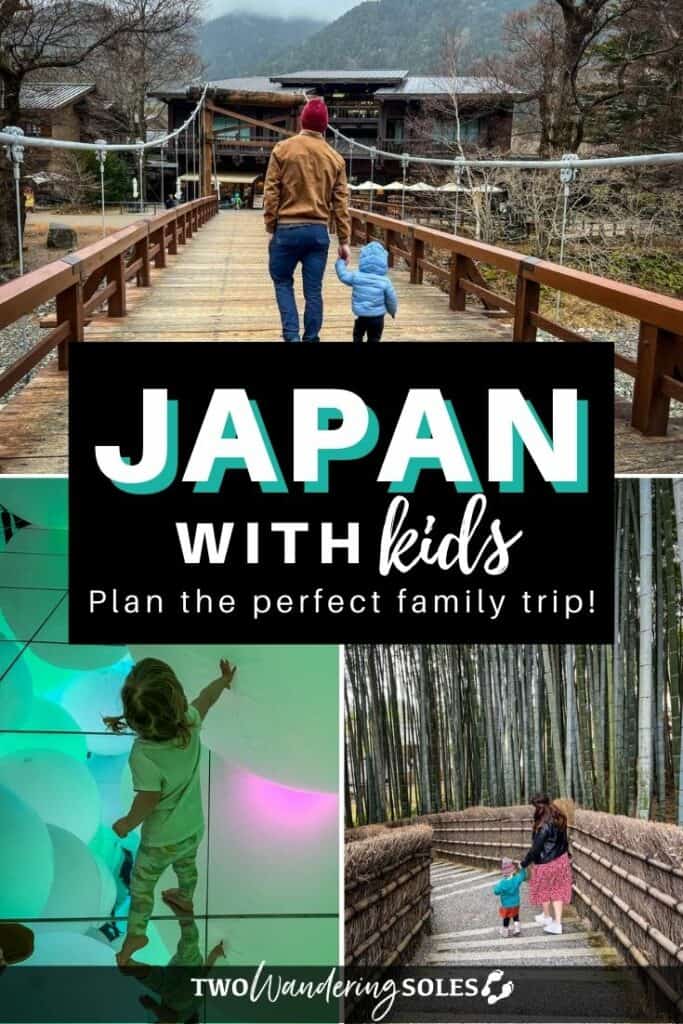
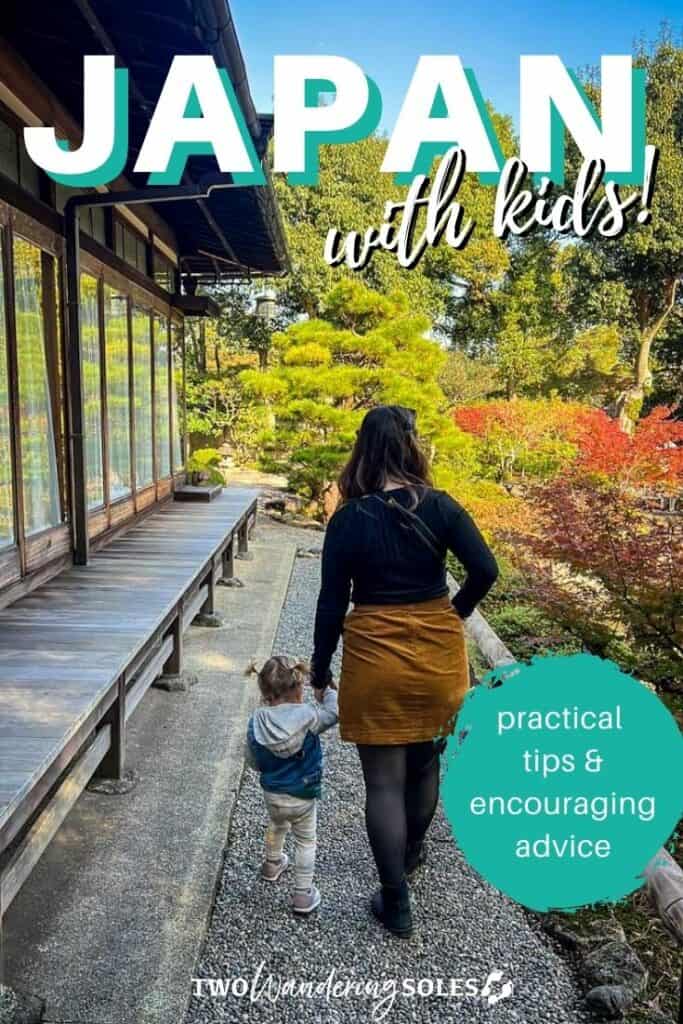
We want to hear from you!
Have more questions about planning a family trip to Japan? Or just looking for some encouragement from someone who’s been there? Leave us a comment below and we will do our best to get back to you!

